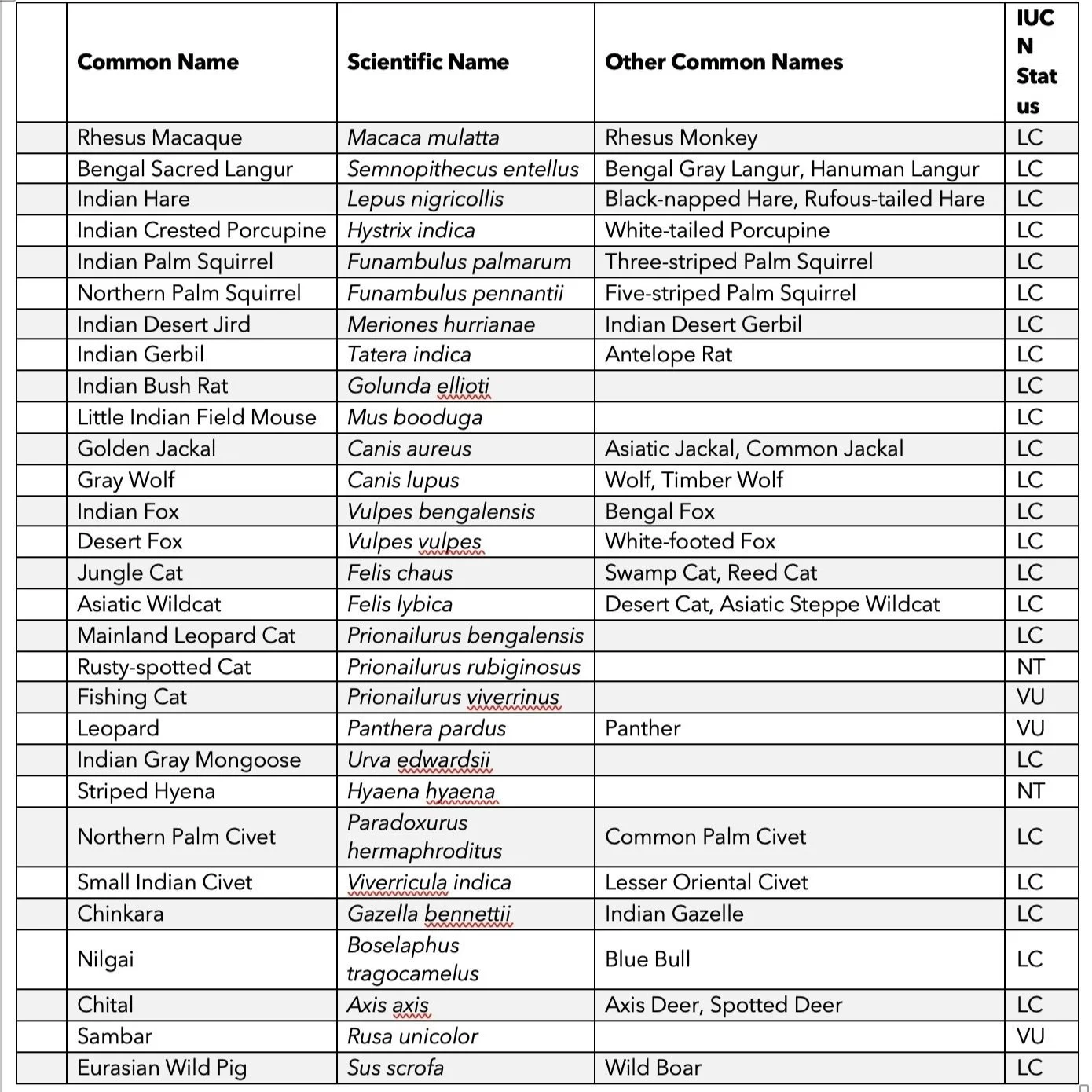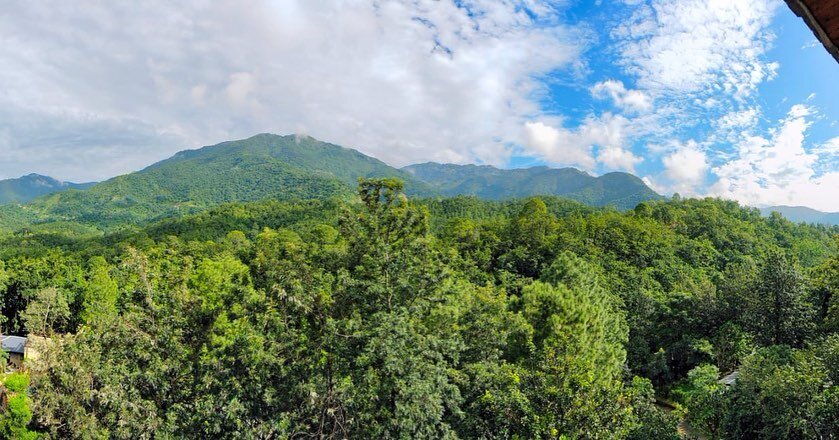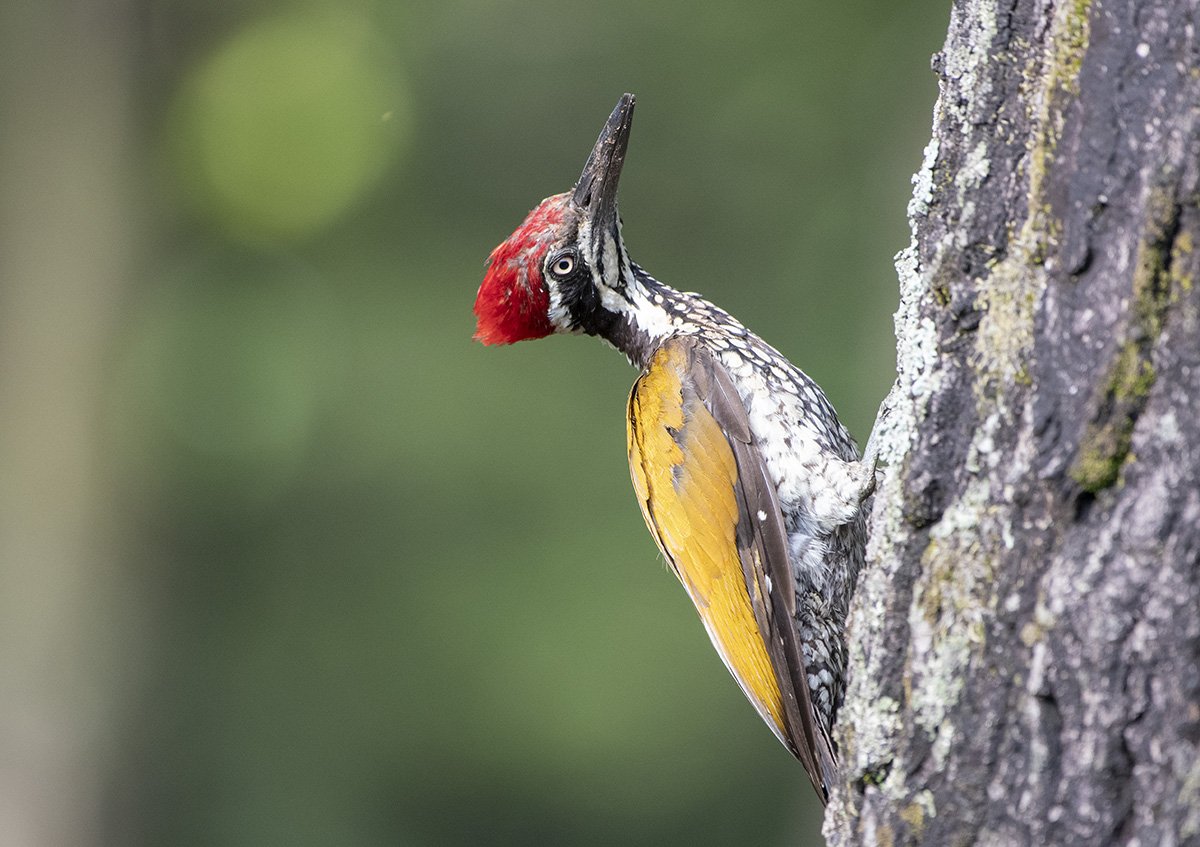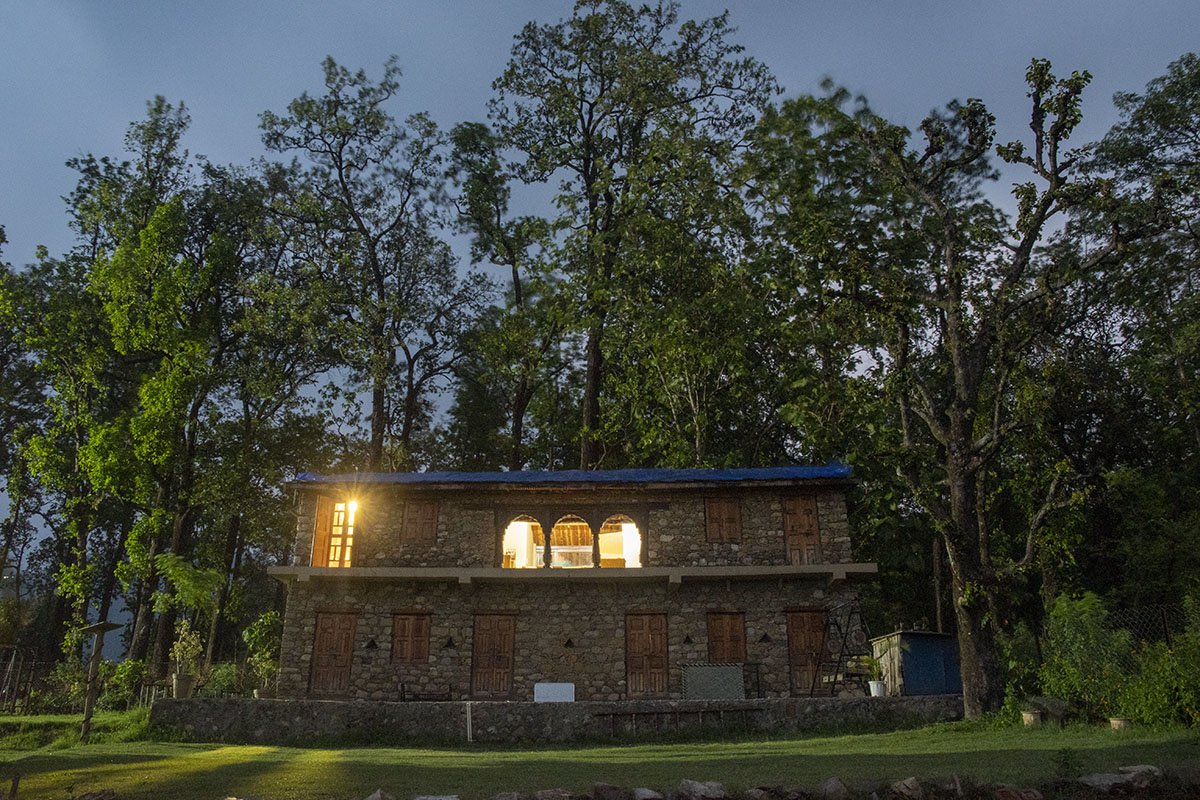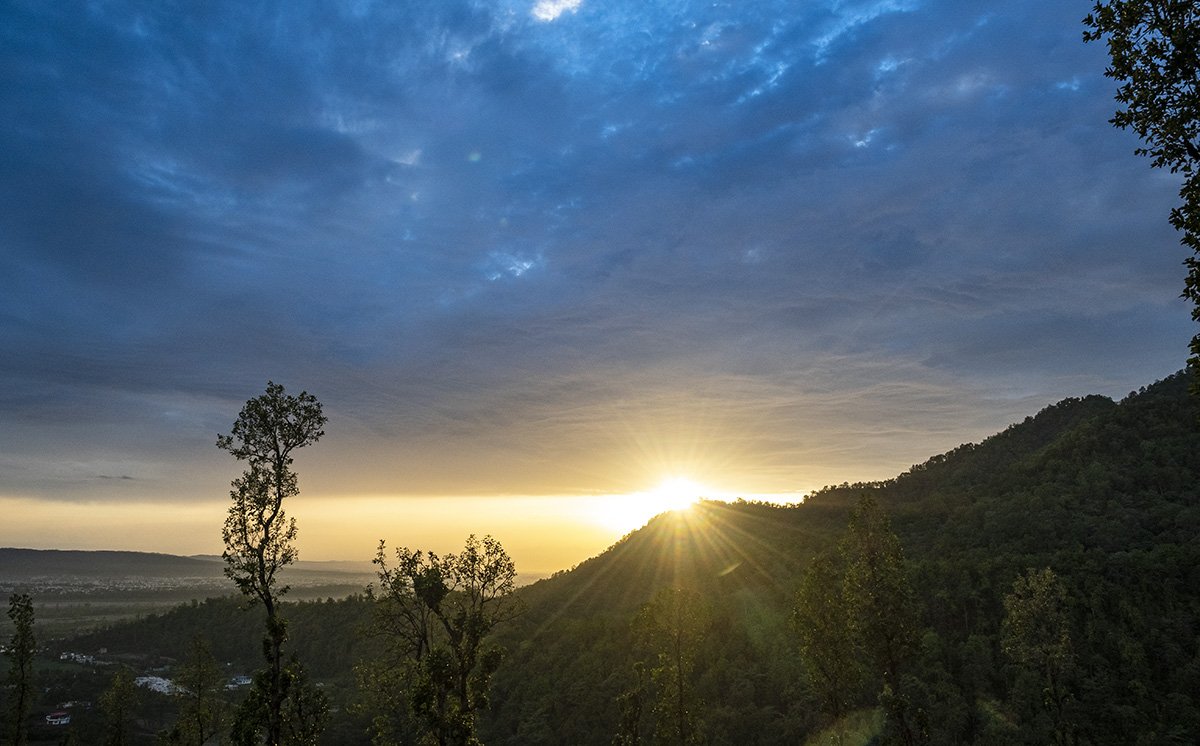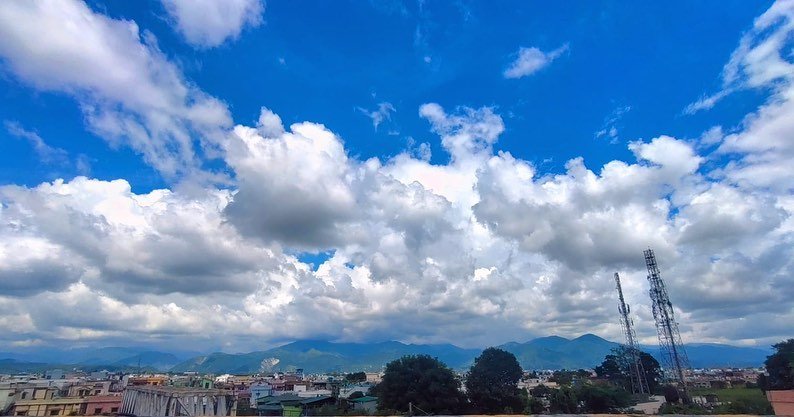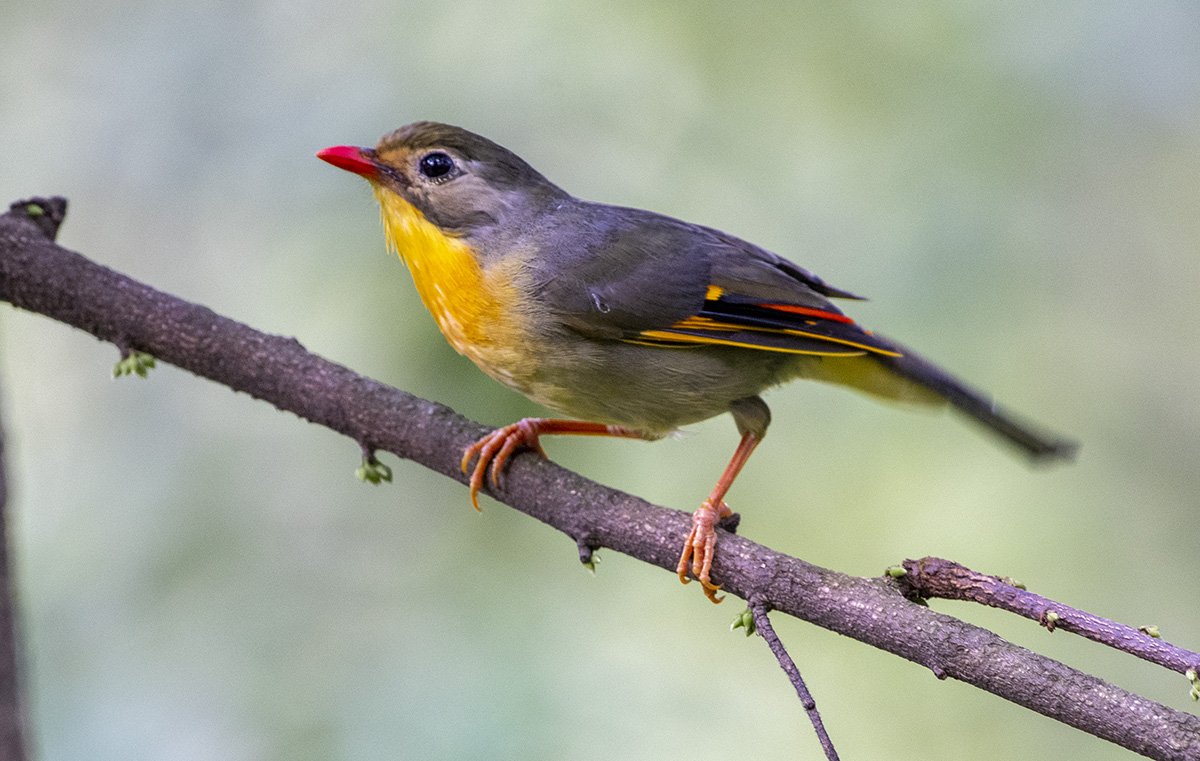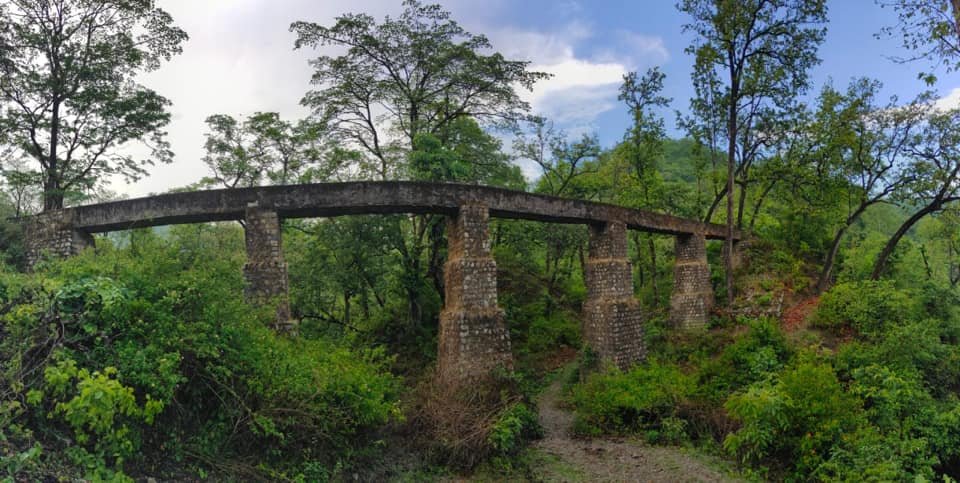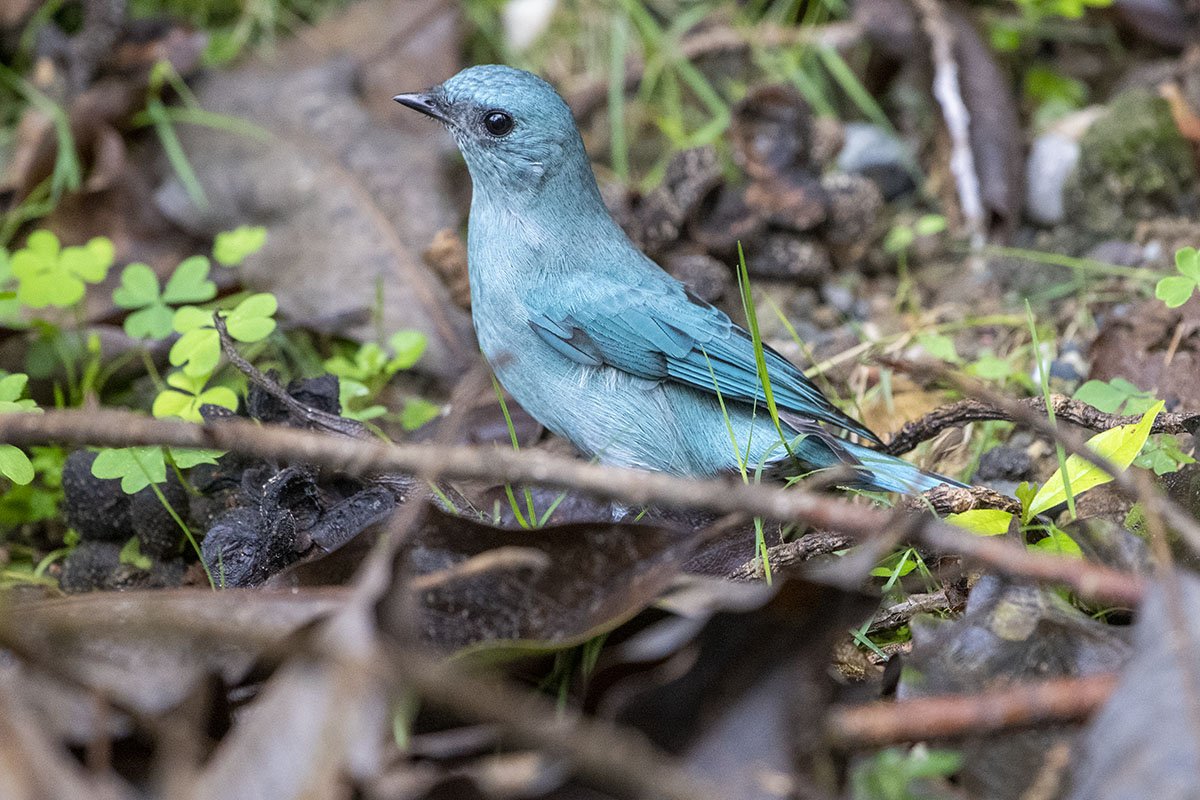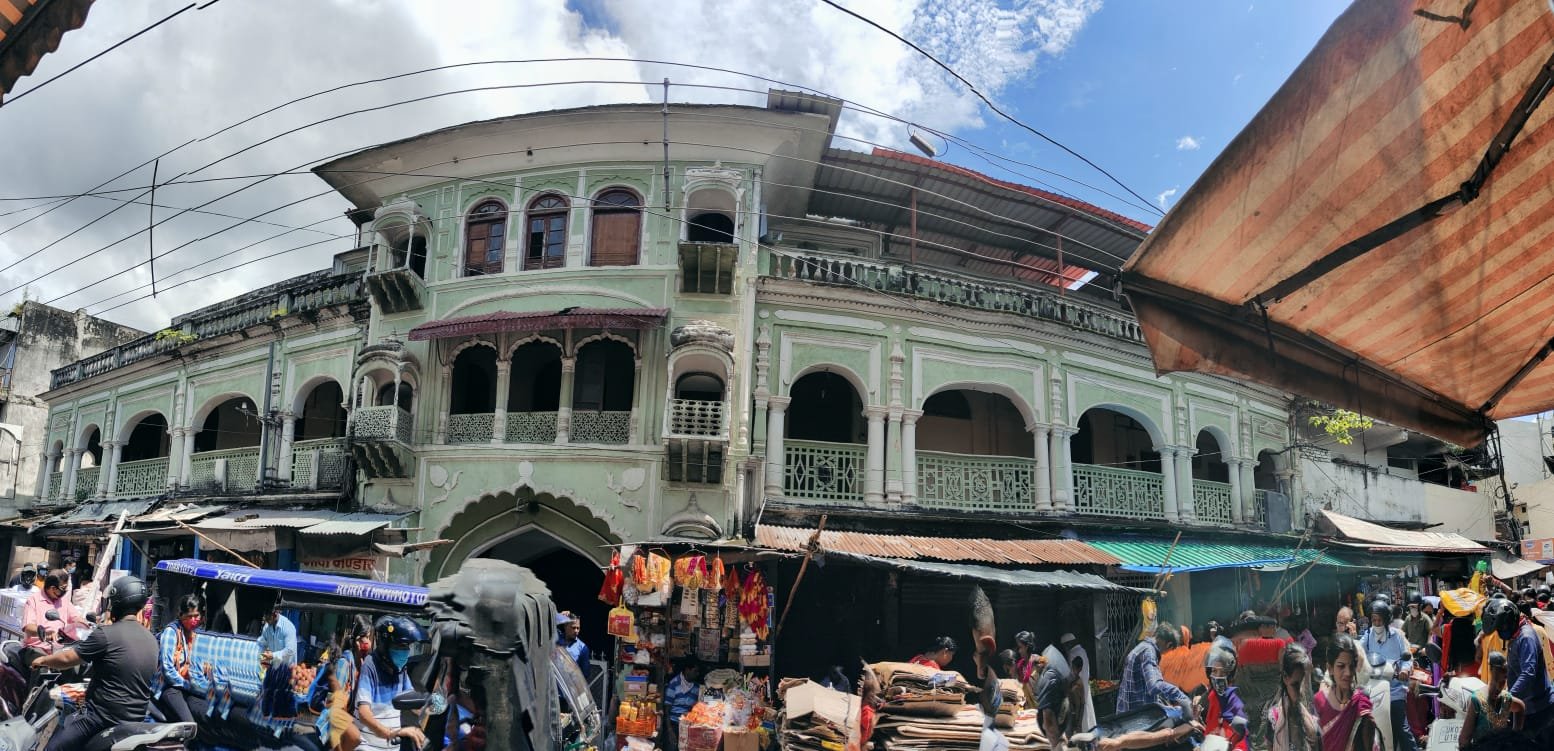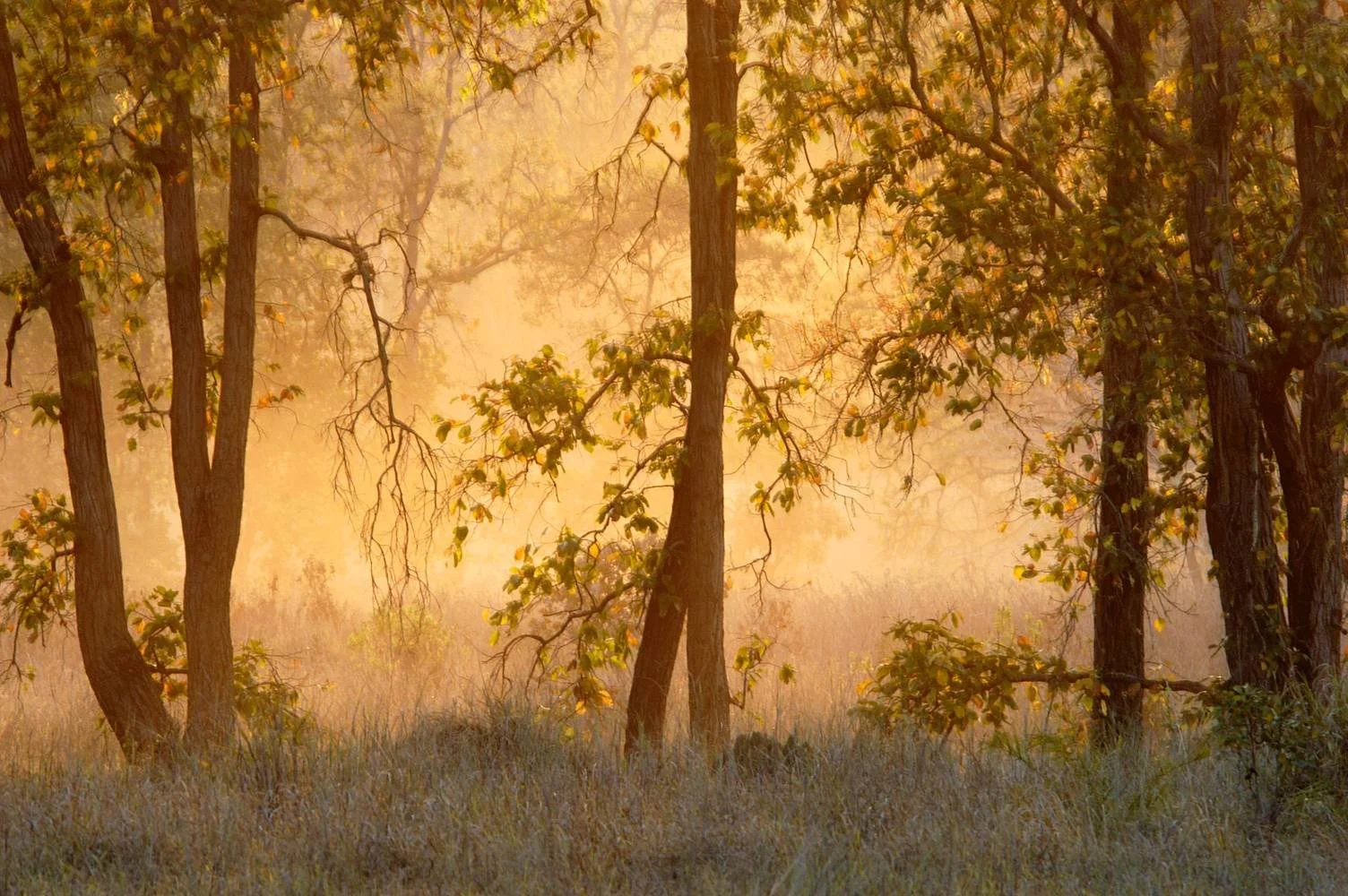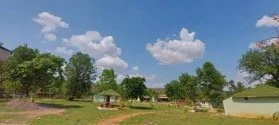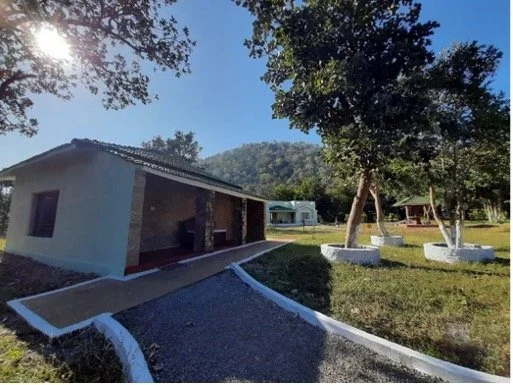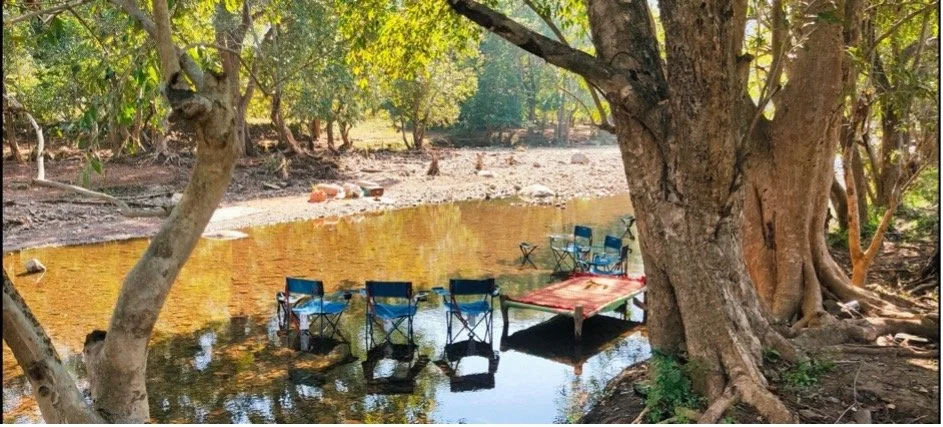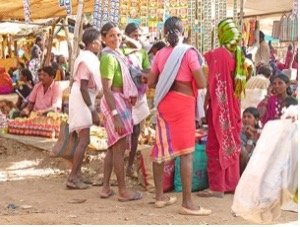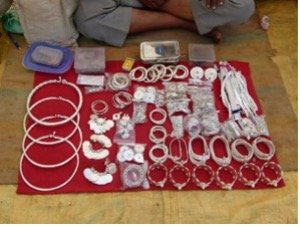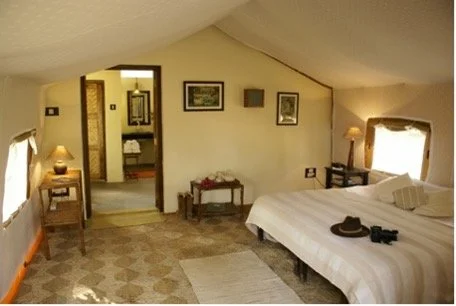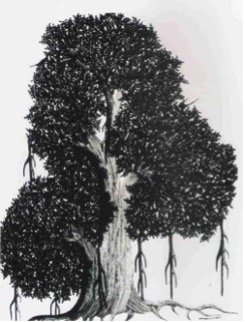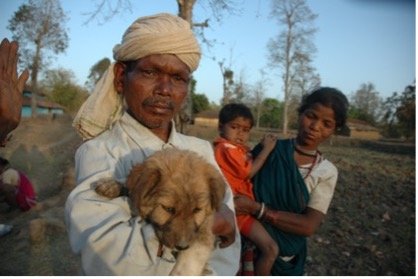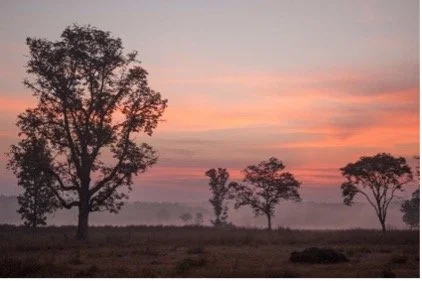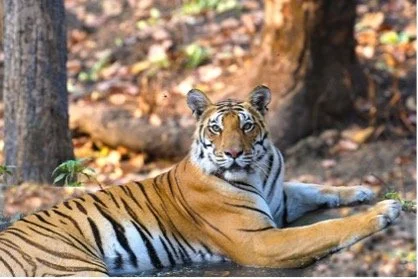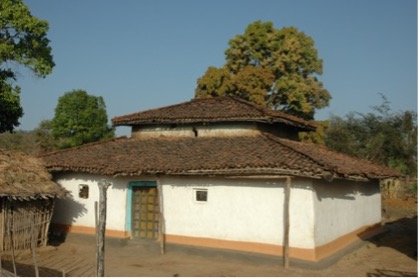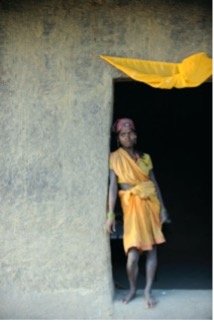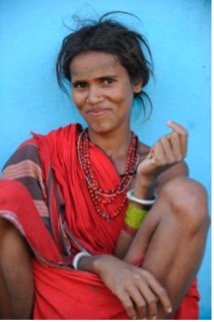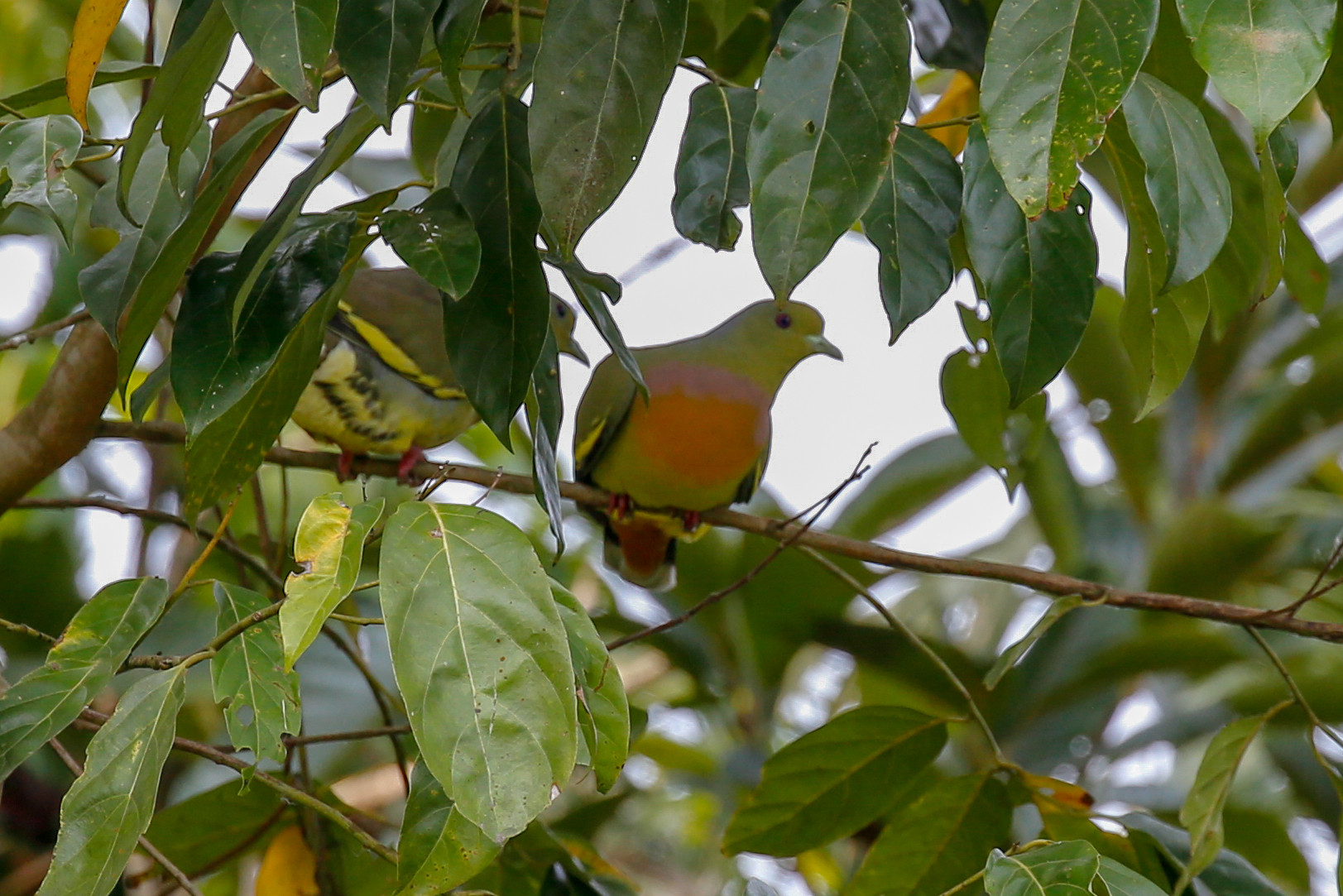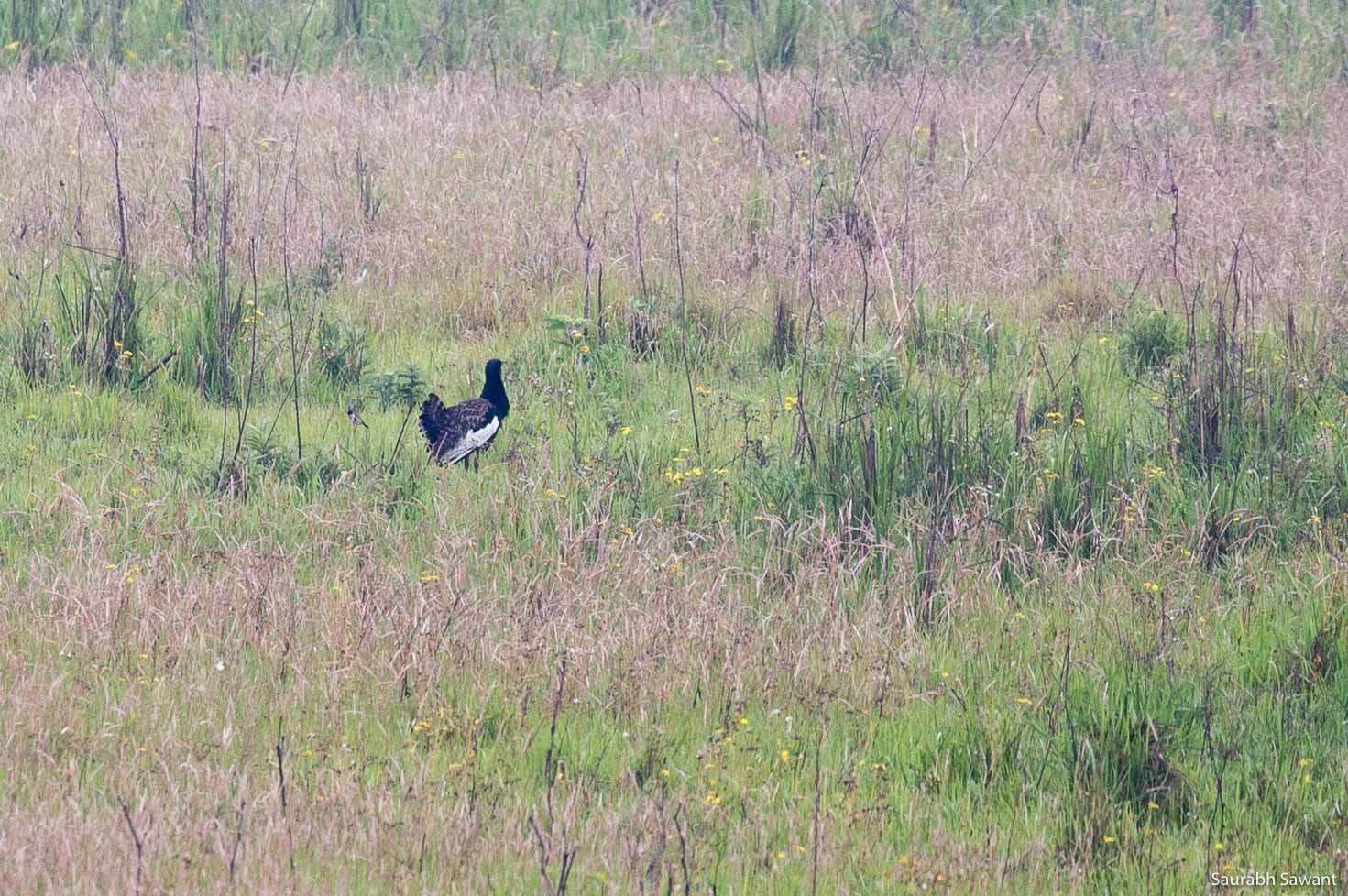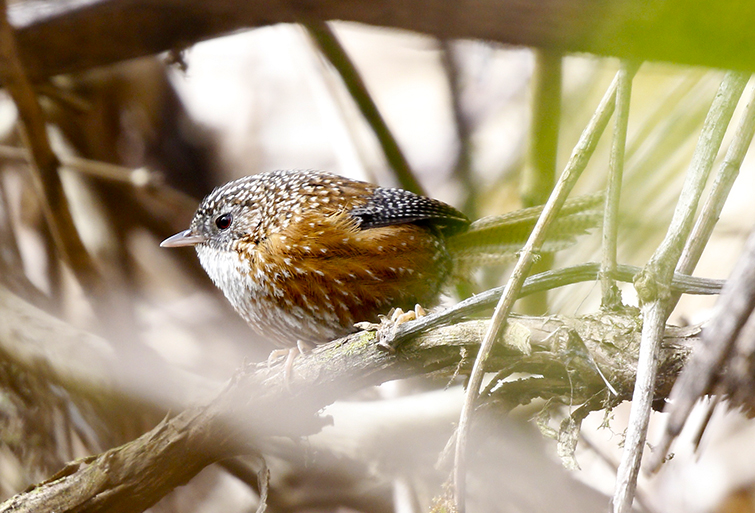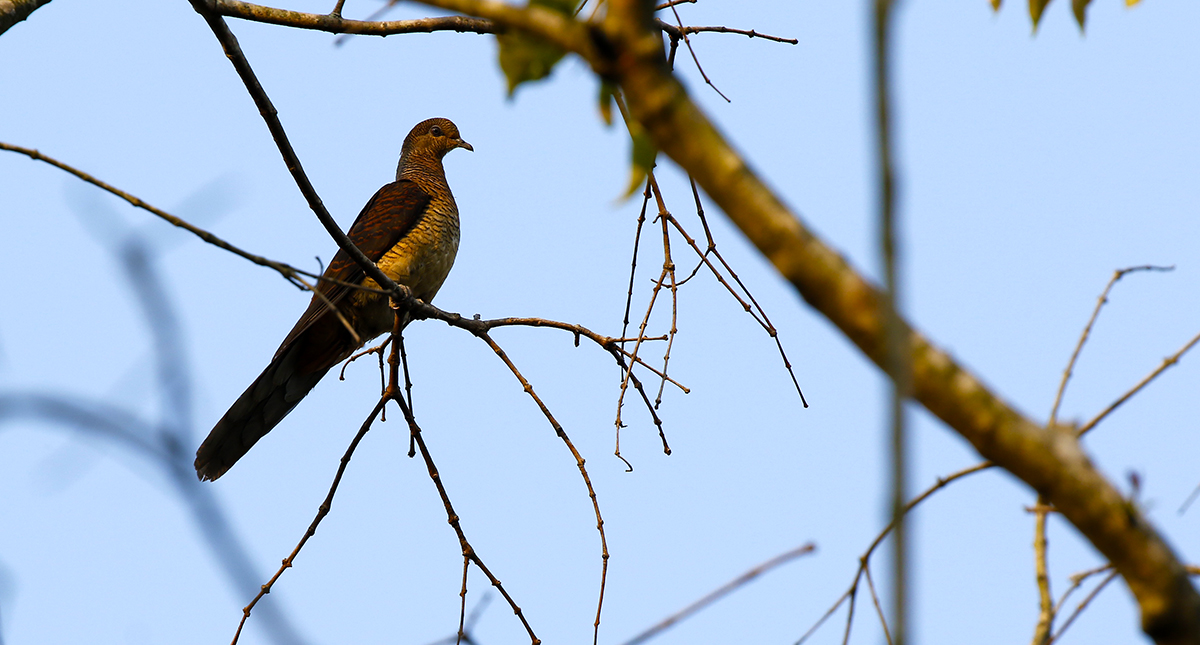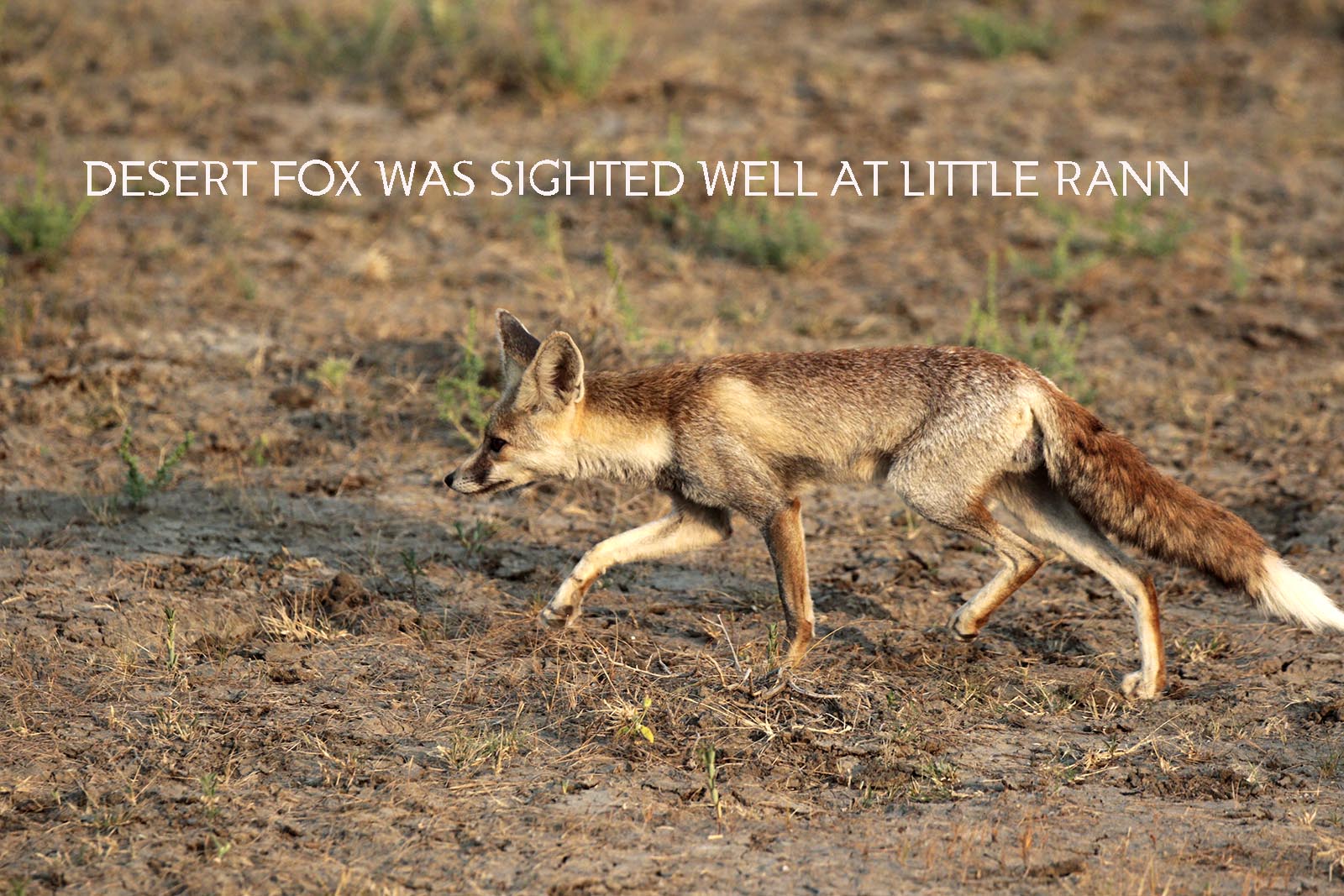
Small Cats Trip Report with Martin & Natascha - Expedition leader-Saurabh sawant
In Search of the Small Cats of Rajasthan& Orissa
A Wildlife Expedition Through Desert Sands, Rocky Terrains, and Mangrove Mysteries
Dates: November 10 to November 22, 2024
Website: www.vanasafaris.com
Instagram: @vanasafaris
Tour Leader: Saurabh Sawant
Participants: Dr. Martin Daniel & Ms. Natascha Daniel
All Images © Saurabh Sawant
The tour was planned based on the infrequent discussions between Avijit the chief planner for Vana Safaris and Dr. Martin Daniel - over 4 years now. The discussions were interesting but somehow the discussions never formed into a tour – though the intent was always there. And so when Avijit heard from Dr. Martin again this year – the discussions started with the possibility of sighting the elusive Clouded Leopard in the deep dark forests of north-eastern forests of India. But the time frame that Dr. Martin had, and the month did not suite an expedition to the north-east.
So based on the idea of Martin and experience of Avijit – a tour was designed focusing on 6 small cats – Jungle Cat, Asiatic Wild Cat, the smallest wild cat – Rusty Spotted Cat, the rarest wild small cat in western India – the Caracal, the elusive Fishing Cat and the Leopard Cat. Since the habitats support at least one wild big cat in abundance – the Leopard was expected to be sighted. A Bengal Tiger was not impossible but was not expected to be sighted. On the other had a no of other carnivores like the Asiatic Gray Wolf, Asiatic Jackal, Bengal or Indian Fox and the White-footed or Desert Fox and the Striped Hyena was also expected to be sighted. Also one had a decent chance to find at least two civets – the Northern Palm Civet and the Small Indian Civet and the nocturnal Indian Crested Porcupine. At its best one could expect about 30 species of mammals in the tour. A no of rare and grand birds were expected with none more rare than the Great Indian Bustard. Apart from that – one would expect a no of raptors like the Steppe Eagle, Greater Spotted Eagle, Imperial Eagle, the endangered Indian Vulture, Red-headed or King Vulture and in the eastern part of India a no of kingfishers like the Black-capped Kingfisher, Brown-winged and Stork-billed Kingfisher, the Pied Kingfisher and the mangrove specialist White-collared Kingfisher.
Avijit needed a very good leader and he decided to ask his old friend and a fine field naturalist Saurabh Sawant to lead the tour. Saurabh has the patience that is needed to lead a mammal tour, he is knowledgeable and is lucky too. He has sighted most of the wild cats of India in the wild and even sighted a wild mainland Clouded Leopard in Arunachal Pradesh. So Avijit knew that Martin and Natascha were in good hands.
So let’s go through Saurabh’s trip diary to see how the trip went through.
10-11 November 2024
Jaisalmer: Secrets of the Desert and the Great Indian Bustard
The journey began with anticipation as I arrived in New Delhi to welcome Martin and Natascha. They arrived in the early hours of November 10th, ready to dive into the wild wonders India had to offer. After a hearty breakfast, we flew to Jaisalmer, Rajasthan—a city of golden sands and timeless beauty. By mid-afternoon, we reached Musa’s Desert Nest, a cozy haven in the heart of the Desert National Park.
That evening, the desert revealed one of its rarest treasures: the Great Indian Bustard (Ardeotis nigriceps), a critically endangered bird. Towering and graceful, two bustards strode across the arid landscape, their presence a poignant reminder of the fragility of this ecosystem. Just as the golden light began to fade, two more joined them in flight, their powerful wings cutting through the desert sky in a breathtaking display. It was a sight so rare and fleeting that it felt like witnessing a secret meant only for us.
The desert had more to offer. On our way back, a Desert Cat (Felis lybica) emerged from the shadows, its sandy coat blending perfectly with the terrain. Martin, quick with his camera, captured the intensity of its gaze. Nearby, a Desert Fox (Vulpes vulpes pusilla) paused momentarily, its large ears and bushy tail illuminated by the vehicle’s headlights. Dinner that night was simple and tasty—a perfect end to an exhilarating day.
The next morning brought even clearer views of the Bustards. Their slow, deliberate movements exuded an air of regality, as though they knew they were among the last of their kind. Chinkaras (Gazella bennettii), their delicate forms bounding effortlessly across the desert, provided a striking contrast. Blue Bulls (Boselaphus tragocamelus), or Nilgai, wandered in the distance, their massive frames a reminder of the desert’s surprising capacity to sustain life. In the evening we explored another far off area where the scrub was dominated by Raptors: Steppe Eagles (Aquila nipalensis), Cinereous Vulture (Aegypius monachus), and Griffon Vultures (Gyps fulvus) perched together, perhaps tired after scanning the sands for carrion.
As we sped across the vast desert in the evening, a Desert Fox caught my eye, its ears twitching above the bushes where it lay camouflaged. The sunset painted the horizon with fiery hues, and we stopped to admire a herd of camels silhouetted against the glowing sky. Their herder, dressed in traditional attire, added a timeless charm to the scene.
Images: Image 1: Cinereous Vulture; Image 2: Great Indian Bustard; Image 3: Indian Gazelle; Image 4: Asiatic Wild Cat/Desert Cat
12-13 November 2024
Bera: Where Leopards Roam Free
Leaving the desert behind, we embarked on a long drive to Bera, a place renowned for its leopards and rocky landscapes. The journey was punctuated by an unexpected stop for roadside tea and a simple breakfast of hot parathas that seemed to taste better amidst the open countryside. Bera welcomed us with its rugged beauty.
On our first evening safari, a Leopard Cub darted across the track, vanishing into the rocky outcrops as quickly as it appeared. It was a brief yet thrilling glimpse of this magnificent predator.
The following morning, the Jawai Hills came alive with a display that will stay with us forever. A mating pair of leopards emerged from their rocky sanctuary; their interactions playful yet commanding. For over 30 minutes, they moved with effortless grace across the granite, their every step a reminder of their agility and power. The drive itself was an adventure, as our vehicle navigated the precarious paths of the rocky terrain, adding to the excitement of the encounter.
Later that evening, we shifted focus to small cats, searching for the elusive Rusty-spotted Cat (Prionailurus rubiginosus), the world’s smallest wild cat. Though the cat eluded us, we encountered another leopard, this one lounging regally on a sunlit rock. The warm hues of the setting sun lit up its golden coat, making it one of the most striking images of the trip.
Images 1,5 - Bera habitat; Image Image 2: Asiatic Jackal; Image 3 &4: A pair of mating leopard; Image 6 - Natascha, Martin and Saurabh in Bera
14-18 November 2024
Ramathra: A Fort in the Wild and the Call of the Wolves
Arriving at Ramathra Fort, perched majestically on the edge of the Kailadevi Wildlife Sanctuary, felt like stepping into a page from history. The fort, with its commanding views of grasslands and farmlands, became our home for three days of exploration. Its ancient walls, steeped in stories of heritage, provided a stark contrast to the untamed wilderness surrounding it.
The sanctuary’s scrublands came alive with a rich tapestry of life. On our very first drive, a pack of Asiatic Wolves (Canis lupus pallipes) emerged, their purposeful strides and amber eyes betraying a keen intelligence. These wolves, smaller and more lightly built than their northern counterparts, are superbly adapted to India’s arid landscapes. Watching them move with such calculated precision was mesmerizing, as if they were choreographing a hunt.
Nearby, a Striped Hyena (Hyaena hyaena) was spotted scavenging on an old carcass. Often misunderstood as mere scavengers, hyenas are remarkable creatures with powerful jaws capable of crushing bone. Their eerie, whooping calls lend an air of mystery to India’s nocturnal landscapes. This individual entertained us as it gnawed persistently, its hunched frame silhouetted against the grasslands.
The early mornings here were magical. One day, a Jungle Cat (Felis chaus) emerged from the scrub, its tawny coat glowing in the soft light. Known for their adaptability, Jungle Cats are often found near wetlands and agricultural fields, where they hunt rodents, birds, and even snakes. Shortly after, an Indian Fox (Vulpes bengalensis), with its slender form and bushy tail, darted through the grasslands. This species, endemic to the Indian subcontinent, is a keystone predator in these ecosystems, keeping rodent populations in check.The Jackals were in plenty on all days scuttling around the scrub and grass.
A visit to the cliffs revealed critically endangered Indian Vultures (Gyps indicus), their massive forms roosting in the safety of rocky ledges. These vultures, once widespread, have seen catastrophic declines due to the use of diclofenac in cattle, a drug toxic to vultures feeding on carcasses. Their presence here was both a marvel and a poignant reminder of the fragility of life.
The nights at Ramathra brought a mix of adventure and introspection. Candlelit dinners in the fort’s courtyard sparked lively conversations. We discussed Martin’s photographic techniques, Natascha’s keen observations on animal behavior, and the quirks of tracking elusive cats. Over laughter and shared stories, these moments became as memorable as the wildlife itself.
The elusive Caracal (Caracal caracal), known for its striking black ear tufts and incredible leaping ability, continued to evade us. But the sanctuary had one last surprise: a Rusty-spotted Cat (Prionailurus rubiginosus), the smallest wild cat in the world, no larger than a domestic kitten. Its diminutive size belied its fierce hunting prowess, and we watched in awe as it sat near the roots of a bushy tree and then moved stealthily through the grass.
Images: Image 1: Jungle Cat or Swamp Cat/Reed Cat; Image 2: CLiff or Indian Vulture: Image 3: Striped Hyena Image 4: Crested Porcupine; Image 5: Brown Fish Owl; Image 6: Striped Hyena with kill; Image 7 & 8: Asiatic Gray Wolf; Image 9: Rusty Spotted Cat
19-22 November 2024
Bhitarkanika: The Mangrove’s Hidden Gems
Leaving Rajasthan behind, we flew east to Odisha and entered the lush world of Bhitarkanika National Park. This UNESCO-recognized wetland is a haven for aquatic life, mangrove forests, and elusive predators. The shift from arid scrublands to tidal waterways was striking, and Bhitarkanika’s unique ecosystem offered a refreshing change of pace.
Our first boat ride through the park’s intricate canals was a sensory delight. Towering Saltwater Crocodiles (Crocodylus porosus) basked along the muddy banks, their prehistoric forms radiating an aura of quiet dominance. The largest reptiles on Earth, these crocodiles are apex predators, capable of taking down prey as large as deer or wild boar. Seeing them in their natural habitat, their massive jaws agape in a cooling posture, was both thrilling and humbling.The mangroves were alive with the calls of kingfishers. Among the seven species we encountered, the Black-capped Kingfisher (Halcyon pileata) and the Brown-winged Kingfisher (Pelargopsis amauroptera) stood out for their vibrant colors and darting movements. Their fishing techniques, characterized by precision dives, were a joy to watch.
The star of Bhitarkanika, however, was the Fishing Cat (Prionailurus viverrinus). Adapted to life in wetlands, these cats are excellent swimmers and rely heavily on fish for sustenance. On two memorable evenings, we found a Fishing Cat perched on the bank, its piercing eyes scanning the water. For nearly half an hour, we observed it foraging, eating, grooming and more, its every movement a masterclass in stealth and patience. Watching it consume successfully caught fish was one of the trip’s most rewarding experiences.
Walking through the mangroves revealed more wonders. While we didn’t encounter a live King Cobra, we did find its shed skin—an eerie yet exciting reminder of its presence. The Water Monitors (Varanus salvator) added a prehistoric touch as they lumbered through the undergrowth, while Indian Chameleons (Chamaeleo zeylanicus) clung to branches, their color-changing skin a marvel of adaptation.
On our final evening, as we patrolled the edges of the mangroves, a shy Leopard Cat (Prionailurus bengalensis) emerged. Smaller than a Fishing Cat but equally captivating, it moved with feline grace, blending seamlessly into the foliage. This sighting felt like a culmination of our efforts—a fitting farewell gift from the wild.
A Bittersweet Goodbye
As we returned to Delhi, the reality of parting ways set in. Martin and Natascha, with their boundless enthusiasm and thoughtful questions, had become more than just guests—they were companions on a journey of discovery. Bidding them farewell at the airport was bittersweet. While the joy of shared experiences lingered, there was a tinge of sadness knowing our adventure had come to an end.
Reflecting on the journey, I realized it wasn’t just about ticking species off a checklist. It was about connection—to the wilderness, to the intricate web of life, and to the people who share in its wonder. The stories we now carry—of leopards on granite rocks, crocodiles in tidal waters, and the laughter around dinner tables—are an evidence to the transformative power of nature.
Images: Images 1 - 3 - habitat; Image 4: Black-capped Kingfisher; Image 5: Brown-winged Kingfisher Image 6: Collared Kingfisher; Image 7 & 8 Fishing Cat; Image 9 Leopard Cat; Image 10: Water Monitor Image 11: Fishing Cat; Image 12: Salt-water or Estuarine Crocodile
A Bittersweet Goodbye
As we returned to Delhi, the reality of parting ways set in. Martin and Natascha, with their boundless enthusiasm and thoughtful questions, had become more than just guests—they were companions on a journey of discovery. Bidding them farewell at the airport was bittersweet. While the joy of shared experiences lingered, there was a tinge of sadness knowing our adventure had come to an end.
Reflecting on the journey, I realized it wasn’t just about ticking species off a checklist. It was about connection—to the wilderness, to the intricate web of life, and to the people who share in its wonder. The stories we now carry—of leopards on granite rocks, crocodiles in tidal waters, and the laughter around dinner tables—are an evidence to the transformative power of nature.
Birds sighted:
Great Indian Bustard. Ardeotis nigriceps
Egyptian Vulture Neophron percnopterus
Indian Vulture Gyps indicus
Cinereous Vulture Aegypius monachus
Eurasian Griffon Gyps fulvus
Steppe Eagle Aquila nipalensis
Imperial Eagle Aquila heliaca
Pallid Harrier Circus macrourus
Pallid Scops Owl. Otus brucei
Black-capped Kingfisher Halcyon pileata
Brown-winged Kingfisher Pelargopsis amauroptera
Lesser Adjutant Stork. Leptoptilos javanicus
Collared Kingfisher Todiramphus chloris
Whimbrel Numenius phaeopus
Eurasian Curlew Numenius arquata
Common Redshank Tringa totanus
Reptiles sighted:
Saltwater Crocodile. Crocodylus porosus
Hardwick’s Spiny-tailed Lizard Saara hardwickii
Indian Chameleon Chamaeleo zeylanicus
Common Water Monitor Varanus salvator
Are you interested in learning more about our tours & would you like us to customize a trip that fits your requirements; we would love to do that - please do fill the form below if you are interested and press the submit button.
Dehradun at a slow pace
A Short Account of a visit to Dehradun
In March 2020 we finished our last pre-Covid tour and sent our clients back home. After that till now - it has been a difficult time for people in travel business. However - this has also been a time when people have looked into their lives and many have started a new enterprise or something different that would sustain them and keep them engaged.
Our story is no different. We (myself and Monika) suffered from Covid 19 in September 2020 and after a month we were out of our house for the first time. The illness made us realise that Covid 19 is quite a serious respiratory illness that can very easily be fatal.
Monika started a small business to focus on her innate being - M I R A I M A I A - (insta handle @miraimaia) and she decided to work with her mentor Sangeeta Khanna (insta handle @sangeetaamkhanna) based in Dehradun. Miraimaia works with wild edibles and brings back lost recipes and natural food back to the kitchen.
So this meant that we had to be in Dehradun a few times in the last few months and it allowed me to see some nice birds, a few interesting insects & a lot of trees and plants.
Dehradun gets its name from the word Dera - meaning home and Doon meaning valley. Three or four decades back it was a green forested valley with slow life, long conversations over cups of steaming tea and long walks in the hills. Today the city is busy place with traffic and a lot of people but the hills are still green and bird song is still there.
So it makes for a great getaway since Delhi is only 4 hours now.
Our short visit was at a time when Dehradun was the ‘go to’ place for a lot of Delhites & so we wanted to a quiet secluded place in the folds of the hills. Monika found ‘Pathal’ a four bedroom vacay spot a few kilometres away from the crowds. It was made in the vernacular style of architecture, was right next to a natural forest & was not a luxury place but quiet.
Well, we drove away in our Honda Jazz CVT - a real pleasure to move out of Delhi & in style. We reached Dehradun just in time for a quick meet up with Sangeeta & her birder husband Arvind - then we drive to Pathal. It was nice place - could have a bit better maintained but the natural saal (shorea robusta) forest was treat. The birdlife was good and it offered great views of the valley. It’s perfect for backpackers & those who really value peace & quiet. Not the cleanest rooms, the food was a bit of a let down but I hope the owners see the potential of the place and do it up a bit.
We checked in - had a round of tea & pakoras and then waited for Sangeeta & Arvind to join us. Once they arrived - we showed them the rooms, had a second round of tea and & pakoras & enjoyed a gorgeous sunset! The rains were still round the corner and over the next two days - it was a quite & busy days & nights as Monika and Sangeeta were busy with brainstorming on the ideas, trying out recipes, working on the pricing of the products - me and Arvind, helped them (or annoyed them at times), enjoyed photographing the birds & had some lovely walks. Of course the food was a very big highlight for us - foraging a bit, getting the fresh fiddle-head fern fronds and making fresh pizzas (all thanks to Sangeeta) - it was an absolute gastronomical delight! Those who do not follow her - you do not know what you are missing - instagram handle @sangeetamkhanna & those who love wild food, processed just right with no preservatives delivered to their kitchens you must follow @miraimaia to taste some of the most delightful recipes.
Before we knew - our time was over and we breezed through the Dehradun - Delhi traffic to be back in Delhi! A few images to help you have an idea of our time in Dehradun!
Exploring Mahua In Sacred Gondowana Land with Sangeeta Khanna & Vana Safaris
EXPLORING MAHUA IN THE SACRED FORESTS OF GONDWANA LAND
WITH SANGEETA KHANNA & VANA SAFARIS
HIGHLIGHTS:
v CELEBRATING MAHUA – EXPLORING THE TRADITIONS, UNDERSTANDING THE PLANT & THE CULTURE ASSOCIATED WITH MAHUA.
v EXPLORING & TASTING TRADITIONAL RECIPES, IDEATING & CREATING NEW USES
v EXPLORING RURAL MADHYA PRADESH & CHATTISGARH WITH LOCALS
v A SAFARI TO THE KANHA NATIONAL PARK
v RELAXED, SLOW PACED WALKING EXPLORATIOSN TO VILLAGES & MARKETS
v UNDERSTANDING & WITNESSING VERNACULAR ARCHITECTURE
v SEEING THE BEATIFUL GOND ART & MEETING WITH AN ARTIST
INTRODUCTION:
The area that we fondly call Central India is almost as big as France & it encompasses all of Madhya Pradesh, a slice of Rajasthan, a part of Uttar Pradesh, Chattisgarh and Maharashtra – that is how author and botanist Pradip Krishen has demarcated it. This is a diverse area with wide variety of plants including trees, shrubs and grasslands. The trees of Central India are a set of rather handsome and beautiful trees like the haldu (adina cordifolia), sagon (Tectona grandis), saal (Shorea robusta), anjan (Hardwickia binata), semal (bombax ceiba), mahua (Madhuca longifolia var. latifolia), saaja (Terminalia tomentosa), kurlu (sterculia urens) and many more.
However Mahua is possibly the most well-known of them – for a no of reasons. The first and the most well-known reason is the liquor that is produced from the mahua flower. The second is the importance of the tree in tribal society and its role as tree where there Gods reside. So a Mahua tree escapes the axe most often and gets a very long life. There are other reasons too - “Mahua” is derived from the Sanskrit word madhu, meaning honey. It is one of the few trees well known for thousands of years. The economic importance of Mahua is mentioned in ancient Sanskrit literature such as Vedas and the Ayurveda, as well as in travelogues of foreign travelers. The Persian invaders to this land centuries ago named it ‘Darakht-i-gulchakan’ due to the deciduous nature of its flowers.
A Mahua tree can produce 300 kgs of flower in one season – individual bountiful trees are staked out and piece of cloth is tied to a branch. Once the flowering starts little kids approaching adolescence accompany their elders to the forest with a basket and after clearing the base of the tree collect the flowers carefully and bring them back. Of course, the humans only have what the animals do not – from the dangerous sloth bear & wild boars to friendly langurs and a no of other species like the civets, squirrels and bats feed on the flowers till they are a bit ‘happy’! Birds join the fest too. Even insects like the beetles and ants feast on the flowers.
There are good reasons why so many different species like them – apart from the obvious sweetness and alcohol content – the mahua is a medicinal tree providing high nutrition to the millions of the poor people. The people use it as food, they make a clear greenish oil with it and use it to cure rheumatism, and pains and aches. The oilcake left behind is used as a manure and vermicide.
Mahua being such an important tree also plays an important part in the rituals of this area. There are numerous songs that are associated with the Mahua tree, the tree is worshipped by both the Baigas and the Gonds.
Come & explore this beautiful tree-culture and enjoy this specially curated event in Central India with Sangeeta Khanna and Vana Safaris.
Sangeeta Khanna, along with local tribal folks, will demonstrate how this season is so crucial for the forest economy and culinary traditions in this area and how we can learn from their ancient wisdom that's deeply rooted in nature and the cycle of seasons. Since Mahua is a great forest resource that has been underutilised or wrongly represented, our focus is on bringing Mahua to our modern kitchens and utilise it to supplement our food while supporting the forest economy that plays an important role in making the food system a bit more fair and climate resilient at the same time. Sangeeta has planned a few tasting sessions with mahua so it will be a multisensory experience for all of you, something that will help you connect the dots about what we lack in our urban lives and how easy it is to just connect with the people at the grassroot level to bring more value to our lives.
A magical land and forest awaits us in this trip
Sketch Program
26TH APRIL’ 22 TUESDAY DAY 1 RAIPUR - BHORAMDEO
Arrive at Raipur – driven to Bhoramdeo – introduction & first outing in the fields + visit to Bhoramdeo Temple. Chattisgarhi dinner with Mahua cocktail.
The Takshak Eco Farm in Bhoramdeo is our first base - for two nights.
27TH APRIL’22 WENESDAY DAY 2 BHORAMDEO
Morning walk to the villages to see/join women mahua-pickers, followed by riverside breakfast. Day activities/discussions with Sangeeta Khanna. Post lunch village/market visit.
The riverine areas are just perfect for a cool breakfast
28TH APRIL’22 THURSDAY DAY 3 BHORAMDEO – CHILPI – KANHA
Morning walk to villages followed by breakfast & further discussions/activities focused on mahua and the culture about mahua. Post lunch – driven to Chilpi village market. Then driven to Kanha National Park. Evening a curated dinner.
The Markets or haats are the best place to meet the Baigas.
The Baiga jewellery in the market
29TH APRIL’22 FRIDAY DAY 4 KANHA
Early morning – join the mahua pickers in Kanha & visit a home to see how they work with mahua. Post lunch, a safari to the park to spot wildlife and see the flora of Kanha.
The beautiful tent - aptly named ‘Mahua’. Shergarh is one of few lodges where the names of all of the tents are after the beautiful plants and trees of Kanha.
After Takshak Eco Farm - the Shergarh will allow us a bit of luxury in the middle of Kanha Reserve Forest. These tents are comfortable with a lot of oomph and charm.
30TH APRIL’22 SATURDAY DAY 5 KANHA
After a relaxed breakfast, explore the nearby villages on foot – exploring & discussing on the vernacular architecture, meet some rural ladies & learn about their food. If we can get to meet a hand-poked tattoo maker (Godna) , we will be able to see the beautiful tattoos that are made by these ladies and have a discussion on that.
Enjoy seeing the Gond art in the lodge. Finally, enjoy a dance by the local baiga community & a curated al fresco dinner.
1ST MAY’22 SUNDAY DAY 6 KANHA – RAIPUR AIRPORT DROP
Depart after breakfast to Raipur airport.
QUOTE Max group size 10 persons
INR 59950/- per person based on twin sharing based on a minimum participation of 5 persons.
Single Supplement – INR 15800/-
INCLUDES –
v Accommodation on twin sharing basis
v One jeep safari in Kanha with a naturalist/driver
v Walks & nature explorations
v Entrances to the park
v Activities as per the itinerary
v Accompanying expert tour leader and local guides
v Taxes
DETAILS OF TRANSPORT & STAY:
v TRANSPORT AIR-CONDITIONED TEMPO TRAVELER/LOCAL CAR OR JEEP INSIDE KANHA
v ACCOMMODATION TWIN SHARING IN TAKSHAK ECO CAMP & SHERGARH TENTED CAMP
A beautiful national park that invokes the mind and the spirit.
The Tiger depends on a good mahua bloom - more mahua means more herbivores who are a bit slow with an overdose of mahua flowers and that allows the hunter a better chance to succeed in her endeavours.
The tiger is not just a physical being, it is a spirit & a metaphor. The baigas believe that the tiger will protect them in the forest & the Gonds portray them as a deity in their paintings.
A Birding Trip to Arunachal Pradesh and Assam April 2019
Birds & Mammals of North-east India
With Vana Safaris April 2019
The northeast of India is one of the most productive & sought after birding destinations in the world. The incredible combination of various habitats & elevations in the Kaziranga- Eaglenest circuit boasts of great number of species of mammals and birds. From floodplain grasslands to trans-himalayas, this is a unique tour that is a must do for every birder.
Day 1 - Sunday, 23 April 2019 Kolkata
Kolkata is situated on the banks of the River Hugli and is close to the Bay of Bengal. Kolkata is on the Indo-Gangetic plain and is at sea level throughout. Most of the city was originally marshy wetlands and remnants are still to be found where it has escaped urbanisation or has not been converted into commercial wetland fishery use. 300+ years of human habitation has led to the establishment of mature trees and shrubs and large groves and gardens are common today. Most large cities in India hold a surprisingly diverse population of birds despite the ever-increasing bustle of humanity, dwindling habitat and life-threatening pollution. Kolkata city is no exception. Both local residents and the traveler to the city can expect to see well over a hundred species, over a few pleasant winter mornings, in the immediate neighbourhood of the city. Good birds like Stork-billed Kingfisher, Lineated and Blue-throated Barbet, Fulvous-breasted Woodpecker, Black-hooded Oriole, Bronze-winged Jacana, Chestnut-tailed Starling, Richard’s Pipit, Bengal Bushlark, Brown Shrike and others are relatively widespread and often common in and around the city.
Birding started early and within a few minutes of leaving the hotel the group was at the Rajarhat Wetlands and the Bengal Bushlark was in the bag. Within a short while a good view of the Oriental Pratincole was obtained through the scope and after a bit more time good birds like the Yellow Bittern, Open-bill Stork, Striated Grassbird, Zitting Cisticola, Greater Painted Snipe was sighted well by every one. After the morning birding at Rajarhat wetlands - the group headed back to the comforts of the hotel. Phil and I went looking for the Indian Pitta and the Firethroat that had been sighted in the last couple of weeks in Kolkata outskirts. It was also important for Phil to see the locations and plan things for the next year. Well- being a Sunday the local birders and bird photographers were out in droves looking for the two species - which made our task impossible. However some other good birds like the Indian Blue Robin, Lineated Barbet, Rufous Woodpecker, Brown Fish Owl, Black Hooded Oriole and a few other species made up for the lack of the Pitta and the Firethroat. Back at the hotel in the afternoon - it was good to relax and get ready for the early flight next morning.
Day 2 - Monday, 22 April 2019 Guwahati to Kaziranga
We landed Guwahati airport around 8:30 in the morning and drove straight to Kaziranga infinity lodge for lunch, with a small tea and pakora break on the way. It’s a 4-5 hour drive that passes through the unique landscape of Assam with crowded streets of some small town and villages and vast stretches of paddy fields with occasional waterbodies that keep throwing interesting birds on your way once in a while. We saw the Black- billed Rollers, Lesser Adjutant Storks, Black Drongos and also a lone bull elephant near Deepor Bheel. There were also forest guards keeping an eye on him to avoid any conflict with traffic and people. We reached infinity and checked into our rooms and after a quick lunch that included variety of authentic Indian dishes. After lunch we went straight to the safari in the central zone, closest to the resort. We were greeted by a number of birds and of course the majestic Rhinos, Elephants & Water Buffalos right in the first safari. Some highlight birds were A Pallas’s Fish Eagle on the nest, Spot-billed Pelican & Striated Grassbird.
Day 3 - Tuesday, 23 April 2019 Kaziranga
We got up early morning at 5, to search for the elusive Blue-naped Pitta at a nearby location. After a few minutes of initial search we heard the Pitta a few times but it never showed up
and didn’t call for long. We ended the search quickly as we had to reach the eastern zone for safari. Woolly-necked Stork, Lesser Whistling-ducks, Red Junglefowl, Orange-breasted Pigeon, Blossom-headed Parakeets, Hair-crested Drongos & Pale-chinned Blue Flycatcher were some of the interesting sightings. During the evening safari at the central zone, we sighted a Kalij Pheasant in display, Grey-headed Fish Eagle, Chestnut-headed Bee-eater but the showstopper was a beautiful Tiger in the fading evening light on the riverbank. We returned with the surreal scene etched in our memories.
Day 3 - Wednesday, 24 April 2019 Kaziranga
This morning we went birding along the Panbari forest and got great views of several birds such as the Hill Myna, White-throated Bulbul & Green-billed Malkoha. Heard a Great Hornbill really close and also saw a Malayan Giant Squirrel. From there we headed straight to the eastern zone for the morning safari and saw the Greater Adjutant, Eurasian Wigeons, Spotted Redshanks in breeding, Glossy Ibis and Crested Serpent Eagle with other commoners. We had Swamp Francolins in the scope on the far bank today and also glimpses of the skulking Slender-billed Babblers which kept calling really close.
Day 5 - Thursday, 25 April 2019 Kaziranga & Nameri
Morning Elephant Ride was excellent with close encounters with lot of Swamp & Hog Deer, Rhinos & a family of Wild Boar. After the ride, we did quick birding session and tried for the Blue-naped Pitta and got lucky with several brief but in-the-open views of this elusive bird as it hopped across narrow trails in an adjoining forest patch. We headed straight to the safari in the central zone from there and managed to get the Slender-billed Vultures, Dusky Warbler, Great Myna & Square-Tailed Drongo Cuckoos. We packed after the safari and left for Nameri. After lunch we did a short walk from the campsite to the river, highlights were the beautiful River Hornbill that flew across the river. We returned early to rest as we had a long walk into the Nameri Tiger Reserve scheduled next morning.
Day 6 - Friday, 26 April 2019 Nameri
We had an early tea and picked up our packed breakfast, all set for the walk into the Nameri forest to get the rare White-winged Duck. On the way we got a lovely Ruddy Kingfisher, the Indian & Great Thick-knee, Dollarbird, Great Hornbill etc. After carefully checking every pond on the way we finally got the White-winged Duck, calmly swimming and feeding in the last pond. We observed it for some time in the scope and quietly turned around. We saw the Abbott’s Babbler, Common Kingfisher & a Sand Lark on the way back. In the evening we did a short walk around the campsite and enjoyed the antics of a Capped Langur troop, and also visited the Pygmy Hog Conservation centre.
Day 7-11 Saturday, 27 April 2019 - Wednesday, 1 May 2019 Nameri - Eaglenest WLS Camps
We started post-breakfast in hope to reach Eaglenest WLS.
Eaglenest (or Eagle’s Nest) Wildlife Sanctuary (27º02´–09´N 92º18´–35´E; 200–3,200 m) and Sessa Orchid Sanctuary (hereafter SOS; 27º06´–10´N 92º27´– 35´E; 250–3,000 m) are located in West Kameng district, Arunachal Pradesh, in north-east India. Both ENS (217 km²) and SOS (100 km²) were notified as protected areas in 1989. The Kameng river and its tributaries (Tipi and Sessa) drain the area. There are a number of small natural pools on the Piri-la ridge at 2,600–2,900 m, which range in size from tiny pools to 0.2 ha. Annual rainfall varies from <1,500 mm onorthern slopes to >3,000 mm on the southern slopes. Heavy snowfall is experienced in winter on Piri-la, while it is medium to low in other areas (especially above 2,000 m, occasionally down to 1,800 m). There are diverse habitat types because of the great altitudinal range. Tropical wet evergreen and semievergreen forest occurs in the southern parts of both the sanctuaries, especially in the river valleys and stream gorges, mainly below 900 m. ENS, SOS and adjacent areas are among the last large tracts of contiguous wilderness left in Arunachal Pradesh. This region is part of a global biodiversity hotspot (Myers 1988, 1991) and part of the Eastern Himalaya Endemic Bird Area (Stattersfield et al. 1998). It is nothing short of a birding pilgrimage for any birder to visit this area and get to see the Himalayan birds of this area. A high diversity of mammals. butterflies and moths along with a huge variety of flowering trees keeps the observer busy and occupied even when the birding is not so great.
However the rain-gods had other plans. But after entering Arunachal at the Bhalukpong entry gate and driving for another 15 km. We came to a halt due to 3 heavy landslides. We assessed the situation and thought it’d probably take more than one day to cleat the debris and open the road. So after some to and fro discussions with the back office and the driver we decided to take an alternate route from Orang and reach Lama Camp. We had lunch on the way, picked up some fruits and groceries and finally reached Lama camp around 6 pm. Due to the long drive we avoided having any extra stops for birding but we did manage a couple of species on the way. We stayed at Lama camp that night. Next 3 nights were spent at Bompu and again last night was spent at Lama camp. We mainly covered the areas between Lama Camp & Sessni (below Bompu). Target locations being Bompu, Sessni & below, Sunderview, Chaku, Eaglenest pass. Although we were hit mostly by pretty bad weather on every day and had really short birding windows between ‘foggy-very foggy- impossible to see’ weather pattern with some intermittent drizzle, we braved it everyday with multiple birding sessions and managed to get decent views many target species. Highlights were Green & Purple Cochoa, Hill Partridge, Kalij Brownish-flanked Bush Warbler Pheasants, Asian Emerald Cuckoo, Grey Nightjar, Golden-throated Barbet, Grey-chinned & Short-billed Minivets, Pygmy Cupwing, Grey-bellied Tesia, Chestnut-headed Tesia, Black-faced Warbler, Mountain Tailorbird, Broad-billed Warblers, a number of Leaf Warbler species, Golden-breasted, Rufous-winged & Yellow-throated Fulvettas, White- breasted & Black-throated Parrotbills, White-naped, Whiskered, Stripe-throated ,Black-chinned& Rufous-vented Yuhinas, Golden & Rufous-capped Babblers,Rufous-throated Wren Babbler, Slender-billed & Streak-breasted Scimitar Babbler, Grey-throated Babbler, Blackish-breasted Babbler (Sikkim Wedge-billed Babbler), Spot-throated Babbler, Himalayan Cutia, Striated, White-crested, Bhutan, Chestnut-crowned, Grey-sided & Blue-winged Laughingthrushes, Beautiful & Rufous-backed Sibia, Bugun Liocichla, all Minlas, Large & Small Niltavas, Lesser Shortwing, Spotted Elachura etc. We also incidentally spotted a few rare mammals such as the Himalayan Masked Civet & Leopard Cat.
Day 12 - Thursday, 2 May 2019 Lama & Sangti
We tried for the Bugun Liocichla in the morning around Lama camp, before breakfast and some of us managed to get brief but good views of the bird. Some of us made excellent recordings of the singing individual. On the same trail we had the Scarlet Finches & Gold-naped Finches. Later, we headed back to the campsite, had our breakfast, packed and started our journey to Dirang. On the way we got mixed flocks of Minivets, Sibias, Sunbirds, & Flycatchers. We got a few Blue- capped Rock-thrushes down on this road. Drive to Dirang was comfortable but we didn’t stop much due to traffic and nick of time as we had planned for an afternoon session at Sangti valley. We reached the hotel at Dirang, took our lunch and after quick rest started for Sangti Valley. Sangti valley is a picturesque village on the bank of Sangti river. Our main target here was the Long-billed Plover which we managed to find within first five minutes. Further in the riverbed we found some more Long-billed Plovers, Common Sandpipers, White Wagtails. Some of the important species we managed to see were Slender-billed Oriole & Yellow-breasted Greenfinch.
Day 13 - Friday, 3 May 2019 Sela & Dirang
To reach the magnificent Sela Pass (4200 masl) for pheasants, one needs to wake up at ungodly hours. we decided to start at 3:00am and drove much of the distance in the dark. Beyond Baisakhi we stopped at a couple of vantage points and good lookouts to look for Pheasants. I heard a Monal & some Snow Partridges. I scanned the valley and shouted, a Monal-Monal- Monal. I straight ran to the parked car to fetch the scope. Phil and I, got the Monal in the scope and we all were in sheer awe of the beauty of this magnificent species. Even Rinku, our driver enjoyed the view for some time and kept mentioning how beautiful this bird was. We also scoped out an Alpine Thrush, giving out its unmistakable scratchy song. Top of Sela was foggy & cold but we got some excellent views of at least 30 Grandalas around the lake. Some Rosy Pipits roamed by singing intermittently. We also got lucky with a few views of the Brandt’s Mountain Finches which are uncommonly seen around here. The weather like it rapidly changes in the hills, became windy & chilly, with plenty of fog coming in. We decided to take the much needed break and the hot tea and maggi noodles came to the rescue. We drove further ahead on the road with no luck with the weather and decided to head back. Made a quick stop at a local hotel for some lovely lunch and went straight back to the hotel to take the much necessary rest.
Day 14 - Saturday, 4 May 2019 Mandala & Dirang
We started around 5:30 am to Mandala and were soon greeted by a Plaintive Cuckoo & the Blue-throated Flycatcher nicely singing despite the constant drizzle. Close by a Chestnut-headed Tesia showed up itself pretty well. Up around the Mandala road we managed a brief view of a Thrush followed by excellent views of a Himalayan Buzzard. In the bushes a Brown Bush Warbler was singing its odd song, while a Brownish-flanked Bush Warbler added to it. The efforts to get any good views of the Spotted Laughingthrushes were futile due to bad fog and rain but we did manage a lovely view of the Crimson-browed Finches. There were also Russet Bush Warblers, 3 species of Yuhinas, Blackbirds, Sunbirds. Post-lunch session added a Rusty-flanked Treecreeper around beautiful Rhododendron forest to our list.
Day 15 - Sunday, 5 May 2019 Dirang & Tezpur
Due to the probability of road blocks on the regular Bhalukpong route (a result of the recent earthquake & the Phani cyclone on the east coast) we decided to take back the alternate Orang route which was excellent to drive on. It also gave us a few birding opportunities enroute that added a few birds to the final list such as the White-throated Needletails, Nepal House Martins, Black Eagle and the Siberian Stonechat.
Day 16 - Monday, 6 May 2019 Guwahati & outbound
Tezpur to Guwahati was a long but comfortable drive through the busy streets of several small Assamese towns and with the respite of a tea break. We were soon onboard our flights to Kolkata and eventually the journey back home with vivid memories and a list of over 300 species from the northeastern India.
Mammals of North-western India, with Marc and Peggy Faucher
A TOUR THROUGH GUJARAT, RAJASTHAN AND MADHYA PRADESH LOOKING FOR CATS AND OTHER SMALL AND BIG MAMMALS
23rd October 2016
The tour had been planned when Peggy and Marc were in north-eastern India looking for the elusive and shy small cats found there and we had decided to do this in October 2016. So it was great to meet them at the airport on the 22nd noon.
Peggy and Marc arrived from Nepal after their trek to Dolpo area passing through several high passes and seeing some stunning mountain scenery and looking very fit - the day before and had some rest and came over to our house in Dwarka for dinner. We regrouped early in the morning of 23rd and flew Jet Airways to Rajkot.
We landed at the Rajkot airport and left for Gir - took us 3 hours 10 minutes through mostly good roads. We left for the first safari immediately and went in to zone 6. Gir has 8 zones of which one is rarely open ( a short zone to Kamleshwar Dam and back) so effectively it has 7 zones. We were at 2 & 6 and it was a beautifully forested area with some dry deciduous forest mixed with teak. We had a few interesting birds - colourful green bee-eaters darted from the branches and the kingfishers (White-throated and Common) showed up well. We saw our first mammal just outside Gir - a Grey Mongoose that crossed the road. We saw Spotted Deer and Sambar and missed a pride of 6 lions that we so wished we had not missed. We checked in to our lodge - Lion Safari Camp located in one corner outside the town of Sassan and settled in for an early dinner.
24th October 2016
We left at 0530 hours to the park and got in to the zone 5. Highlights of the morning were a mating pair of leopards that played hide and seek for a while and eventually offered us excellent views. We also saw Sambar and a confiding Blue-bull. New Birds included a few White-eyed Buzzard and Yellow Throated Sparrows. We returned from the park at 0930 hours and had some rest before heading back to the park to zone 7. In hind-sight a poor decision. We did see some nice mammals and birds but we missed the pride of lions that posed in route 6 that we nearly got. We should have stuck to route 6 - you will see why.
25th October 2016
We had route 3 in the morning and route 5 in the afternoon - we did manage a lovely sighting of a male leopard that was 'sawing' (Peggy heard him and he sawed again in a few minutes time) and we managed to see it quite well in the end with both Marc and me getting some good images. We were disappointed not to see Asiaitic Lions and hope that we see one on the way out early in the morning on 26th.
26th October 2016
We left Gir early today and tried for the lions outside the park - we saw a couple of Asiatic Jackals and one unidentified mammal that just was too far to id. We realised that the lions were simply not around and started the drive to Kutch. The roads in Gujarat are in excellent condition and we drove north to Rajkot first where we stopped for a while and then carried on to Bhuj reaching around 1300 hours. From Bhuj to Nakhatrana took anouther hour and we reached CEDO Birding Lodge run by Jugal Tiwari around 1400 hours. We were greeted at the gate by Jugal and then showed our simple but well appointed rooms and after a delicious lunch we left for the long afternoon safari towards Banni grasslands. We saw the Desert Jird soon - a few of these inquisitive little mammals showed well. We also saw several European Rollers, a Great Grey Shrike, a few House Sparrow (burkini race), a fly by Indian Rock Eagle Owl and a few other birds. On the way back we followed a Jungle Cat as it took a stroll in front of our car through the town.
27th October 2016
We started early at 0600 hours and headed back to Banni where we hoped to see the Desert Cat and possibly the Desert Fox - but we were disappointed - we explored a large area almost seeing no mammals - the reason possibly lies in over-usage of pesticides, illegal hunting and commercial wind-mill farms coming up in Kutch. A lot of the fields that we covered produced no mammals. We returned for lunch and then left with Jugal to explore some of the most beautiful habitats that Kutch could offer. We did see a few interesting mammals - Indian Field Mice, Grey Musk Shrew, a couple of Indian Hare and lone Indian Fox was sighted in the evening. We did have two cats cross the roads but from a distance where we could not id them properly.
28th October 2016
We were a little relaxed about the lack of mammals and enjoyed the morning seeing a few birds with Vaibhab - Jugal's brother in law and a naturalist. He was kind enough to be out with us at odd hours and showed us the rare and endangered White-naped Tit. We also saw some amazing rock formations and a no of Fan-throated Lizards. This evening we managed to find a few good mammals we had Bare-bellied Hedgehog, a Desert Cat and an Indian Fox. We had a lovely dinner under the open sky. Jugal and his team were tireless, very warm and very knowledgeable and we would have loved to spend more time with them. But the lack of the mammals made us change plans and decide to leave next morning to Little Rann.
29th October 2016
We left after a nice breakfast and headed to Little Rann of Kutch (for no better name to this amazing place). It took us a little over 5 hours to reach and the roads were again excellent. On the way we managed a stop at the Pereshwar temple where we picked up the Greater Mous-tailed Bat, House Mouse and an un-identified Rat (possibly Rattus species). We did stop at the beautiful Bhuj House of Jehan and Katie Bhujwala - beautiful homestay in Bhuj town in the Parsi colony. They alreay run a camp in Kanha and this is a recent addition.
We were entertained by our driver who had sighted a Caracal some days back and casually mentioned it to me when I asked him if he has sighted any cats on his drives recently. We just laughed at the irony of life. We reached a busy Rann Riders and after lunch jumped into our jeeps to head to the Rann. We saw a few Asiatic Wild Ass within minutes of reaching. They were amazingly patient with us and allowed us to walk within about 100 metres from them. Possibly they thought of us as salt-workers in Diwali costumes. We also managed to see a glimpse of Desert Fox and a good view of the Indian Fox. We did see a large no of Greater Flamingo, Marsh Harriers, Common Cranes and some other interesting birds. On the way back at the Jinjiwuada town we managed to find a few Indian Flying Fox and also several Greater Mouse-tailed Bats.
30th October 2016
We left early to the Rann and were rewarded with an up close encounter with the Desert Fox. We did see McQueen's Bustard (6 individuals), Rufous-tailed Shrike, Desert Warbler and some other interesting birds. We returned in the evening and tried for the Jungle Cat and the Fox (both species) but failed to find one. On the way back we found an injured Indian Krait and we stopped to move it out of the road. However the lack of equipment, light and safety gear resulted in a few anxious moments but eventually we managed to put it way from the road after some effort.
A Journey to South Assam Hills
A Journey to South Assam Hills - April 2013

A Typical day in a Village in Nagaland
The South Assam Hills has always been a secret hide-out for several species of skulking birds that few birders in India and abroad have ventured to see. This area is home to several range-restricted species of laughing thrushes at least one parrotbill and a few babblers. It is also home to an amazing bio-diversity and it is the home of the Nagas. They have the reputation of practising head-hunting until recent times - there is no reliable definition of 'recent' - at least till the 50's. It is an extremely difficult area to travel specially if you are a vegetarian. The Nagas love to eat meat - period.
So it was with some trepidation and a lot of excitement that I looked forward to the tour with my birding friend from Kolkata - Arka. We had just done a trip to Arunachal and agreed that we need to push the envelope a bit. After several phone conversations and emails we were finally ready. Our target was to bird at Pungroe and Khonoma
.
Angulie Megyase from Khonoma was our guide and we made travel arrangements ourselves.

Habitat in Pungroe Village
Dimapur - a dusty city with endless traffic - has the only airport and links Nagaland by air to rest of India. The flight to Dimapur from Delhi was via Dibrugarh. The flight from Dibrugarh to Dimapur is so short that one feels sorry for the passengers of this leg - just a take off and touch down for all the hassles that north-east Indian airports offer to its passengers. After a short while at the airport I located the taxi driver - a
Bihari
settler in Dimapur who had bright yellow Maruti Alto ready for us. By the time we reached Kohima - the town was shut and apart from the few shops here and there. The Razhu Pru is located centrally - it is a nicely run homestay and hotel with well appointed rooms and friendly staff. We unpacked quickly and settled in our room after dinner at the restaurant.
Angulie and the driver appeared after breakfast in a comfy Scorpio and we left for the long drive to Pungroe - a small village with scant settlements and lush forested areas in the surrounds. The route is via Pfutsero and Meluri - winding through some amazing forests and quiet small villages. En route we spoke about birds, Nagaland and the weather. The drive eventually came to an end by day break and we walked in the comfortable PWD bungalow. The excitement about the drive was the flock of Yellow Throated Laughing Thrush that I spotted 23 kms prior to Pungroe. There were at least 12 birds and they offered a brief view. This was a big target for us - so both of us were very happy to see this on our first afternoon.
At 0400 hours I was up - but the it was raining and it did not take much effort to go back to the bed. However light is really early here in Nagaland and we were out at 0600 hours - in hindsight a mistake. The road from Pungroe towards the forest has some good vegetation to its right and we got the Spot Breasted Parrotbill here within a short while of playing out the tapes. Two birds came up gave us a photo-op and disappeared back fast.We trudged along the single track towards Fakim and Penkim. The forest on both sides were thick and full of birds - but sighting them meant playing tapes for a while and a short sight of a bird before it shot back inside the safe cover of thick forest. For good reasons - we were aware of the sad fate of the migrating Amur Falcons that was captured on film by Shashank and his birding friend. Lesser Shortwing (ssp
carolinae
) was heard often and sighted as well. Other major birds sighted included Slaty -blue Flycatcher (ssp
cerviniventris
), Large Niltava, Little Pied Flycatcher, Silver Eared Mesia, Crested Finchbill, a few Slender Billed Babblers, Streak Breasted Scimitar Babbler, Rufous Capped Babbler, and a couple of Amur Falcons. Birding was interrupted a few times due to rain and very poor visibility. We returned for lunch and resumed afternoon birding after the rains stopped. The afternoon was quieter and produced fewer birds - The White Browed Laughing Thrush and Moustached Laughing Thrush tapes were played in the area next to the culvert (the first culvert - to the right with tall grass reeds and forests below) and though the former did not respond - we did manage poor views of the Moustached L.T. This is a not so shy bird but very quiet compared to other laughing thrushes and hence very poorly sighted. A few more Amur Falcons and Streak Breasted Scimitar Babbler were sighted as well.

The Spot Breasted Parrotbills at Pungroe
Next day we stayed put at Pungroe and drove further towards Fakim - the road to Fakim starts with a sudden left diversion on the main road going up to Penkim and Mimi and then it continues to Fakim. The area is relatively open and allows better visibility. We added Rufous Necked Laughing Thrush,
khasiana
race of the Rusty Fronted Barwing, Flavescent Bulbul, Mountain Bulbul, good views of the Scarlet Backed Flowerpecker and Yellow Vented Flowerpecker, Yellow Eyed Babbler, Orange Bellied Leafbird, a single Ashy Wood Pigeon, a distant Rufous Necked Hornbill, a single soaring Black Eagle and a Rufous Piculet.
Spot Breasted Scimitar Babbler was heard several times but it was hard to spot this ace skulker.
Several species were seen again including the Spot Breasted Parrtobills. The afternoon was very quiet today - so after a brief session at Pungroe we drive down towards the area where we saw the Yellow Throated Laughing Thrush and had better views today. On the way back I heard an Eye Browed Wren Babbler but we just could not see the bird.
Our final day in Pungroe - we drove towards Thanamir and birded in the near and surrounds - added the Chestnut Vented Nuthatch, Black Throated Prinia (ssp
khasiana
), a couple of Mountain Hawk Eagles, Yellow Cheeked Tit, the much sough after Long Tailed or Naga Wren Babbler, a few Assam Laughing Thrushes, at least one good view of the Spot Breasted Scimitar Babbler, Maroon Oriole, Yellow Bellied Fantail, Collared Treepie, Spotted Nutcracker, Black Bulbul, a brief view of a
Seicercus sp
warbler which I could not nail and a few other species. In the afternoon we tried again for the Moustached Laughing Thrush and White Browed L.T. but did not get a response. We planned to leave for our next base Knonoma but not before trying for an hour for the two species of Laughing Thrushes. Luckily Arka managed to get one view of the Moustached L.T though the White Browed could only be heard - not sighted. We drove to Khonoma through Phek and Kiphire district and reached late in the evening in time for an early dinner. En route birding was poor primarily because of the heavy slash and burn cultivation which is creating devastation in Nagaland. An erstwhile forested area is being cut and burnt every 4- 7 years and there is no time left for regeneration - birds, mammals, reptiles nothing is spared and if this is not stopped - then there will be no wildlife or forest left in 20 - 30 years.

Chestnut Vented Nuthatch

Golden Throated Barbet

Naga Wren Babbler

Yellow Throated Laughing Thrush
The next few days were spent in Khonoma - this village has created a name for itself for birders after offering protection from hunting for the last few years. This is good news both for the birders and the few small and reasonable small accommodations available here. We stayed in a simple homestay with a local teacher though a slightly better accommodation in a wooden house is also available. The no of rooms in both places are scant - hence before landing up here one should double check on the confirmations. We birded in the outskirts of the village and the Tragopan Sanctuary & drive down to Dzuku area one morning. we saw Mountain Bamboo Partridge, Spot Breasted Laughing Thrush, Assam Laughing Thrush, Spot Breasted Scimitar Babbler, Striped Laughing Thrush, Streaked Scimitar Babbler, Naga Wreb Babbler, Snowy Browed Flycatcher, Ferruginous Flycatcher, Crimson Breasted Woodpecker (ssp
pyrrothorax
), Pale Headed Woodpecker, Golden Throated Barbet, Rusty Capped Fulvetta, Rufous Gorgeted Flycatcher, Green Tailed Sunbird, Small Niltava, Spotted Forktail, Plumbeous Water Redstart, Black Breasted Thrush and few other species over the next three days. We tried hard to sight the Brown Capped Laughing Thrush - that had been sighted by Shashak and Ramki from here - but failed. However we heard the Grey Nightjar, and the Oriental Scops Owl - that responded to the calls but did not show up. We did a trek at the Tragopan Sanctuary - but the Blyth's Tragopan did not appear, the trek can be pretty easy in dry times but quite slippery and perilous in wet periods. The visit to Dzukie or Dzuku Valley was interesting - some great sights of pristine dry forests though the birds were mostly elusive. We did see the Mountain Tailor Bird here.

Black Breasted Thrush

Rufous Gorgetted Flycatcher

Fire Breasted FLowerpecker

Slaty Blue Flycatcher

The Khonoma Village
The mammals sighted included the Orange Bellied and Hoary Bellied Squirrel and a Barking Deer. On the way back I sighted a snake which was green and was being pelted at by the locals - timely intervention saved it but the speed at which it disappeared meant - it could not be identified for sure.
I would love to thank Arka, Shashank and Sujan (whom we met at Pungroe) and Angulie for sharing their knowledge about the birds and birding locations of Nagaland and the knowledge on the birds of this area. Our hosts at Khonoma were polite and though it was not luxurious - bucket hot water on request and simple home cooked food with early morning tea/coffee was never a problem.
Finally one word on Nagaland - the area is still very wild and the various tribes and clans of Nagaland would love to get some more freedom in designing their future. However, with very scant respect for nature they can very easily damage the fragile eco-system which will go against the very idea of self-dependence and freedom. Nagaland is a beautiful area and the best time for birding is certainly April-May, but the period during the Hornbill Festival - 1st week of December can be an interesting time of visit too. Those wishing to visit this place must do some detailed planning and organize things well in advance.
Happy Birding!
Avi

An Afternoon in Ranthambhore
An Afternoon in Ranthambhor -
By mid May the tourists stop coming to India and by June the only foreigners who are willing to dare visit a national park in north-western India are the ones with long lenses - attempting to capture the tiger in their fancy cameras. This allows us - tour organizers an opportunity to 'travel' and do a few things that we cannot do while we are at work. I decided to spend a week in Ranthambhor and try to see some of the cubs that Ranthambhor has been reporting this year. In this part of the world tigers are numbered as T1, T2 and so on. So Machli the female who is now 18 years and has lost her canines but still battling on is T 16, her daughter is T 19 who has three beautiful cubs and so on. The tigers also have names like
Ustad
- the expert one,
Zalim
- the ferocious one,
Sultan
- the king and such like. The names portray the character of the tigers to some extent. Though the scientific community hates to put a product of human imagination on a natural animal, tiger lovers seems to enjoy this practise that started in the 80's with
Sita
and Charger from Bandhavgarh or
Noor
&
Genghis
from Ranthambhor.
I arrive at the Sawai Madhopur station at 2030 hours - transported by an air-conditioned train from a hot and busy Delhi in just over 3 & 1/2 hours. It is hot and busy in the station with people waiting to board trains. I meet my driver and within 1/2 an hour reach Khemvillas - a small lodge owned by Dr. Goverdhan Singh and his charming wife Usha. The cool room beckons me in and after a short and quick dinner I shower and sleep.
Ranthambhor is a legacy from the hunting days of the 40's and 50's and as late as the 60's - the tiger was not sighted here in daylight. In fact in the 70's after the declaration of the tiger reserves most of the sightings were in the night with flashlights & jeep headlights. It was the late Dr. Fateh Singh Rathore - Goverdhan's father - who insisted that the villages inside the park must go out and the tiger must be allowed its space. Fateh slowly and patiently convinced the politicians and the people to leave the park to the tigers and its because of his and his team's efforts that today people come here to see tigers. He passed away after battling it out for some years with cancer - but before he did so he made sure that Ranthambhor has a future for tigers and other wild animals.
I am here to get glimpse of at least one set of cubs and get some photographs. If I sound a greedy tourist - so be it, tiger cubs are cute and adorable and I have not seen one for a while. So I packed my camera bag and decided to spend some time inside the park - hoping to get at least one nice image of them.
The first few rounds were fruitless - I was at the wrong place or the weather was just not right and frustration was slowly building up..will I see a cub, will I be able to get a snap. Well on 24th afternoon we were in route three - this is the area that T19 has been spotted with four cubs - earlier in the year. Sadly while moving her cubs a marsh crocodile grabbed one of her cubs to the dismay of the mother, so three cubs now reamin with the young mother and she had been sighted a few times with the cubs. I prayed for some luck and pulled myself in the car, We headed to the park and parked close to a waterhole. A few more cars had also got the news and we waited under a hot and sweltering sun for the story to unfold. After 10 minutes under the summer Sun and no sign of any life - we moved on to check one of the main lakes of Ranthambhor -
Rajbagh
. The lake is a large one with a cenotaph and a small stone palace at one corner of the lake and it is dotted with large Banyan trees on the same side as the cenotaph and grass beds on the other sides. Deer, crocodile, birds and tigers share space here - the lake is an important water source for the park and its denizens. As we neared the lake we saw T 19 coming out from the one edge of the lake - after taking a couple of shots we left her and headed back to the area where we felt she is heading.
She walked through the valley and reached the area where she had left her cubs. By then we had reached and taken up a position. The female called a few times and bingo a cub came running out.....however the whirr of the shutters and the people was not really what this little thing really liked - so despite the reassurance of the mother - the cub rushed back into a thicket of bushes in seconds.
T 19 called again and now the cubs were more sure - Mom was close and they can hide below mothers towering presence - they came out one after the other - all of 5 months, small, delicate and extremely vulnerable. The mother of course was used to the people and the cameras - she ushered the cubs in the waterhole for a session with the press. The next 30 minutes flew - the cubs sipped the water, played with each other and bonded with the mother. They were sure now of their safety. After what seemed an eternity T 19 finally was up and she then walked all the way back towards
Rajbagh
lake with the cubs - we followed them from a distance. She reached the lake and my hearth missed a beat - after all one cub was eaten up by the crocs - I certainly did not want to see that happen to another one. She must have known to steer clear from the murky waters of
Rajbagh
- she stayed at one edge of the lake on the grassy bed as she confidently crossed the lake area - heading now towards route 4 - towards another lake.
While we guessed that she might have a kill where she was heading back with the cubs in tow - it was time to leave her and head out of the park. I had a soft feeling in my heart...a feeling of happiness and joy. I was happy to get an image but more importantly - I witnessed that despite increasing pressures on the forests and forest-unfriendly governments - India's tigers have some space to themselves.
Tigers are survivors and if we can save these places and somehow can connect them to each other - we will have tigers that our children will be able to see. I cannot imagine a forest without a tiger. It disturb's me, I sincerely hope that those of you who read this blog do make an effort to save the forests that you have in your surrounding areas - an average tree produces enough oxygen in a day to keep one person alive, if we can appreciate that and can save these trees in their natural habitats - we will save our tigers.
Happy birding!....I did see a lot of Indian Pittas and some beautiful Asian Paradise Flycatchers, so there were a few birds around.
A few images for you to enjoy -

T 19 with the female cub

A Leopard sighted in the late afternoon - high up on the fort

This Indian Rock Python can be a threat to the cub in the picture above

A Barred Button Quail in a village looks for food

Indian Pitta migrates from the South by early May and breeds in Ranthambhor

The Sloth Bear is not so common in Ranthambhor - but in summer afternoons they are sighted regularly

Few Birds can match the grace and beauty of a male Indian Peacock

Asian Paradise Flycatchers are very common in Ranthambhor

Matching steps with Mom is not easy - but it is possible
I hope that you enjoy the post - please note that the national parks except some parts of Ranthambhor and Tadoba (in Maharashtra) will get shut from 1st July till 16th October. When they open again - the cubs will be juvenile tigers - getting ready for the real world, facing the tough world where the various non-environment friendly policies and the pressure of the people will make their life a tough one. However I wish to see them again when I am back in Ranthambhor later in the year and will let you know about their story. Apart from T 19, Ranthambhor has at least four other females with cubs - T41, T 39, T 17, - there may be more tigers with cubs in other parts of the park. It will be interesting to see how they fare in the monsoon and what future unfolds for them in the fall when the parks reopen.
Happy birding and enjoy your holidays - wherever they take you.
Snow Leopards of Ladakh
 |
| The Female with a cub |
 |
| The peaks from the flight |
 |
| Eurasian Sparrow-hawk |
 |
| Golden Eagle at Sakti |
 |
| Guldenstadt's Redstart |
On the 3rd day of the acclimatization we went to Chilling – a small village hidden in the folds of the Zanskar River – though we could not see any mammals we did see Snow Leopard tracks on the frozen river. On our return we found that the road-workers had blasted a part of the rock wall and the entire road was full with rock debris – some the size of a soccer ball and some the size of a small one room apartment. Well – without a choice of backtracking and waiting – we had one option – walk past the debris and call for a new car leaving the car we were in at a safe place. The plan worked out well – Dick at 84 was the fittest octogenarian I have ever met and with a little help from me he made to the other side with some photo-stops in the middle.
 |
| Fit at 84 - he crossed those stones |
 |
| The Yeti was finally found |
 |
| The Golden Eagle and Red Fox at Sakti |
On the 22nd we finally left for Ullay. We were actually planned to Rumbak but the visit of the Indian conservationist M K Ranjithsingh resulted in a closure of Rumbak for six days. We were not bothered by this as we had ample time – but such visits must cause some amount of discomfort for people on a short leash and tight budgets. We reached Ullay stopping a few times looking for anything – we did not see any mammals but some Fire Fronted Serins, a few European Goldfinches and Red Breasted Accentors kept us entertained. The scenic of course were grand and layer after layer of snow-covered peaks opened before us.
Ullay - our first base -
 |
| A House in Ullay |
 |
| Camping at Skanda la - Ullay |
 |
| Domesticated Yak - Ullay |
Ullay is a small village located at 13500 feet with about 15 homes – out of which 5 serve as homestays. We stayed in one of them and was surprised by the level of cleanliness. Immediately on arriving at Ullay the crew set up the kitchen, tea & coffee appeared with chocolates. I met our guide Dorje. The two scopes that we were carrying – a brand new Swarovski and a well used Kowa were out in a flash and the first mammal in Ullay – the Siberian Ibex showed up. A small party of 14 Ibex were grazing at the base of the peak opposite the home-stay and we enjoyed good scope views – though they were miles away from us. A short snow-fall happened in the afternoon and that meant that the temperature dipped immediately – Dick had a thermometer with him and in the early evening it showed -160C/30F. The little furnace – locally called ‘bukhari’ – kept us warm through the early hours of the night but it was cold after that. We got up early and after some hot breakfast (cereals, fruits, hot milk, fried eggs, chocolate shakes, tea/coffee), we left for a hike up the hill. At 14000 feet in Ladakh in winter the air is so dry and short of oxygen that going up even a few steps in the wild is a task. However the slope was not too bad and we managed to cover the distance in good time. We were rewarded with good views of the same party of Ibex. We stayed there for a few hours and then descended to the base. Over the next four days we explore Ullay and its nearby areas both in the morning and the afternoon. We could see the elusive Snow Leopard here though we found ample marks of its presence. We did have excellent views of the Bearded Vulture – Lammergeier, saw the Himalayan Snowcock, got a distant view of a Tibetan Wolf and saw Red Fox. We also got a Wallcreeper and a White-browed Tit Warbler.
 |
| Tibetan Wolf |
 |
| Lammergeier at Ullay |
 |
| Dick - watching Ibex |
Rumbak - our second base -
 |
| Blue Sheep |
 |
| The Camping Ground at Rumbak |
Photographing the Stone Marten – Martes foina kozlovi
Tibetan Stone Marten - Martes foina kozlovi is a nocturnal mammal that in India is found from Kashmir to Sikkim at an altitude between 6000-14000 feet. Since it is a nocturnal mammal - hence it is difficult to photograph and I have not seen an image taken by any Indian photographer in India. I was delighted to hear that they have been seen in our campsite and decided to try for an image. This meant braving the cold and sitting out in the night temperature well below sub-zero. I decided I will do that. I had five nights in my hand and the first two were useless as each time I saw the mammal it just disappeared from sight in seconds. On the third a noisy drunk camper from Bengaluru scare the marten and it did not show up for two nights. One night to go - I sat out at 2100. At 2300 hours the cold was numbing my fingers and I was about to give up - I noticed a shadow between the rocks and I knew it was there. The moon had long set - so I had to use the flashlight with me to focus - so I had a Canon 5D Mark III with flash and a 300 f4 in one hand and torch in one hand a very skittish subject to shoot. I just fired a few shots and the marten just went back into its hole. Initial scan showed that most were out of focus - I was cursing and praying at the same time - at 0100 hours when I was half dead it came back and this time I managed two - three sharp images. Voila! I was very happy that finally I have seen this rare and endangered mammal and have something on plate to prove that.
We returned to Ullay – with brief stop at Leh and checked in to the homestay of Nurboo –
 |
| The Ibisbill near Spituk |
 |
| Snow Leopard - Female with cub |
 |
| The same pair |
 |
| Royle's Pika |
Birds seen –
7 Guldenstadt's Redstart - Phoenicurus erythrogastus
9 Ibisbill - Ibidorhyncha struthesi
10 Common Rosefinch - Carpodacus erythrinus
11 Tibetan Plain Snow-finch - Montifringilla adamsi
12 Fire-fronted Serin - Serinus pusillus
13 Horned Lark - Eremophila alpestris
14 Robin Accentor - Prunella rubeculoides
15 Brown Accentor - Prunella fulvescens
16 Dark Throated Thrush - Turdus artogularis
17 Red Billed Chough - Pyrrhocorax pyrrhocorax
 |
| Winter Wren |
A Birder in Tigerland
Plum Headed Parakeet
The northern most park in this set is Panna - it is a semi arid area - though the River Ken flows through the national park - and for that the bird diversity is excellent compared to other similar areas. The key targets in Panna are Painted Spurfowl, Indian, White Rumped and Red Headed Vulture, the Himalayan and Griffon Vulture, Painted Sandgrouse, Jungle Bush Quail, Sulphur Bellied and Smoky Warbler, the beautiful Indian Eagle Owl & Striated Grassbird, White Bellied Minivet, Mottled Wood Owl, Savanna, Jungle and Long Tailed Nightjar, Rufous tailed Lark and Brown Rock Chat. Panna has a healthy no of 20+ tigers at present that are being sighted in regular intervals. Panna always throws up a few surprises - Wallcreeper, Himalayan Flameback, are two birds that have been reported from Panna over the last few years.
 |
| Emerald Dove |
 |
| Grey Necked Bunting |
 |
| Indian Courser |
 |
| Long tailed Nightjar |
 |
| Oriental Whiteye |
 |
| Velvet Fronted Nuthatch |
 |
| Golden Fronted Chloropsis |
 |
| Red Headed Bunting |
 |
| Sirkeer Malkoha |
 |
| Indian Silverbill |
Kanha is a wonderful birding area. It offers quiet undisturbed areas for the birders. I have sighted birds like the Spot Bellied Eagle Owl, Brown Wood Owl, Mottled Wood Owl, Brown Hawk Owl, Grey Headed Fish Eagle, Jerdon's Baza, Blue Capped Rock Thrush, Scarlet Minivet, Scaly Thrush, Tickell's Thrush, Cinnamon Bittern, Painted Francolin, Yellow Legged and Barred Button Quail, Greater painted Snipe, Indian Yellow Cheeked Tit, White Rumped Spinetail, Black Winged and Black Headed Cuckoo Shrike, Rufous Bellied Eagle, Himalayan and Siberian Rubythroat, Orange Headed Ground Thrush and Ultramarine Flycatcher. Birds like Green Munia, Sarus Crane, Pale Blue Flycatcher, Lesser Florican, Western Crimson Sunbird, Chinese Sparrow-Hawk, Crested Tree Swift, Forest Wagtail and Ashy Minivet have been reported as well. There is one report of the Forest Owlet being sighted from outside the park but no one has got a photo of this recently re-discovered species. It is present at Melghat and Orissa and hence Kanha is a possibility for this species.
Pench is a comparatively poorly birded area as most visitors to the park are city-sleekers trying their tiger luck. It is father south from Kanha and is poorly birded - there are some remarkable birds that can be sighted here. Grey Jungle Fowl -is found in the southern edge of the park. There are Orange Breasted Green Pigeon and Greater Flameback, Short Toed Eagle, Long Legged Buzzard and Booted Warbler in Pench - these birds are not sighted easily at the other three parks. Pench also has at least one report of European Bee-eater - a rarity for this area. Other birds in Pench that I have sighted include the Red Headed Bunting, Yellow Crowned Woodpecker, Small Pratincole, Malabar Pied Hornbill, Yellow Eyed Babbler, Yellow Wattled Lapwing and White Browed Bulbul. Pench is a good place for Sirkeer Malkohas too. Not many birders have spent time in the Maharshtra side of the park - primarily because the area is not open to tourists beyond a short distance from the entrance.
Tadoba - is not an easy place to bird - the reason for this is the constant rush to see a tiger or a leopard and the circular pattern of the routes. A birder can feel frustrated here - though there are some good birds here - Grey Jungle Fowl is common, Red Jungle Fowl can also be sighted here. Painted Sandgrouse, Jungle Bush Quail, Tawny Fish Owl, Mottled Wood Owl, Emerald Dove, Grey Bellied Cuckoo, Lesser Yellownape, Banded Bay Cuckoo, Grey Headed Fish Eagle, Oriental Honey Buzzard are some of the birds worth a mention.
Melghat is a tiger reserve but it is the least visited of the lot - I have been there a couple of time - primarily to put a tick on the recently rediscovered Forest Owlet. A few pairs of these birds are there in Melghat area and people who come to see it normally do not do much birding in Melghat. The forest is open but the routes are poorly developed and hence birding is difficult. However, Barn Owl, Mottled Wood Owl, Jungle Owlet, Indian Black Eagle, large Grey Babbler, Tawny Bellied Babbler, Indian Yellow Tit, White Spotted Fantail, Malabar Whistling Thrush, Indian Scimitar Babbler and few other species. Melghat is 5 hours drive from Nagpur and accommodations there are basic - so those who wish to visit this area must keep it in mind.
I wanted to finish this post with Satpura Tiger Reserve. This park is northwest from Kanha Pench and Tadoba and south west from Bandhavgarh and Panna - the location is crucial for the birder as part of the forest is the connecting patch between the foothills of north eastern India and eastern forests and the western ghats. This means several interesting birds from two bio-geographic areas can be seen here. The Malabar Whistling Thrush, Jerdon's Baza, Mottled Wood Owl, Barn Owl, Brown Wood Owl, Sirkeer Malkoha, Grey Jungle Fowl, Red Spurfowl, Spotted Creeper, Indian Skimmer, Flame Throated Bulbul, Western Crowned Warbler, Blue Capped Rock Thrush, Puff Throated Babbler, Eurasian Crag Martin are some of the highlights. There are unconfirmed reports of Black Baza and few other rarities but no one has yet come out with an image.
Well thats some information for those interested to visit these areas - I have also listed my favourite birding lodges - I have kept in mind that a birder enjoys birding in the lodge and tried to balance that with the service and quality of accommodation. A short information on the way to reach these parks is also given below -
Panna
How to reach - (Khajuraho - 30 minutes drive has an airport and a station)
Ken River Lodge - Excellent guides and good location. Downside is that some of the rooms need renovation - they are working on this.
Bandhavgarh
How To reach - (Khajuraho is 5 hours drive; Jabalpur is 4 hours drive and Umaria is the nearest railhead - 45 minutes drive)
Tigergarh - Good location, modest accommodations in a quiet corner of Bandhavgarh. Good for people on a budget.
Kings Lodge - Good location and service. Better for you if you are with a group.
Tiger Trails - Excellent location but a bit run down and service can be lacking.
Kanha
How to reach - (Airports - Raipur - 4 hours; Jabalpur 5 hours & Nagpur - 6 hours drive; Gondia station is 3 hours; All three airport towns have stations too. Bilaspur station is 6 hours drive.)
Shergarh - An excellent lodge for birders who are not on a very tight budget.
Kipling Camp - An excellent lodge for birders - wonderful birding in the lodge premises.
Kanha Jungle Lodge - Excellent for birders - they do host several group tours - so you need to check availability well in advance.
Pench
How to reach - Airports - Nagpur - 3 hours drive; Nagpur has a station too.
Pench Jungle Camp - Excellent for birders, very knowledgeable guides, good accommodation.
Jamtara - New lodge will function this year onwards - a good accommodation for a birder who is happy spend some money.
Tadoba
How to reach - Airports - Nagpur - 3 hours drive; Nagpur has a station too.
Tiger Trail - excellent for birders, good location and nice rooms, but they host groups so make sure that the accommodation is booked in advance before checking in.
Svassara Jungle Lodge - Good lodge, a little too urban but they are working on that. Good service and rooms. Birders would like the proximity to the gate - reducing drive time.
Melghat
How to reach - Airports - Nagpur - 6 hours drive; Nagpur has a station too.
The FRH at Kolkaz - A very basic government run forest rest house with a four rooms.
Hotel Harshwardhan - A very rundown hotel with basic rooms. The property is approached by a narrow uphill road from Melghat forest.
MTDC Chikaldhara - basic but cheap and at least the rooms are spacious.
Satpura
How to reach - Airports - Bhopal - 3 hours drive; Bhopal has a station too. Sohagpur is the nearest station (1 hours drive).
Forsyth Lodge - Excellent for birders. Very good guides and nicely done rooms. Good birding within the lodge premises.
Renipani Lodge - Excellent for birders who can fist out a little more money. Excellent rooms and superb food.
Denwa Backwater Retreat - Great location and very knowledgable guides - not for those on a budget.
Birding with Jonathan Franzen and Sean Dooley
Birding with Jonathan Franzen and Sean Dooley –

Hello everyone – I am sorry to be away for a while and I hope that you have had a good time meanwhile – I have just finished a no of tours to some very bird-rich areas and that too with two well know birders from the Globe – while Jonathan Franzen is a well known author and is possibly America’s best known author, Sean Dooley is Australia’s ‘birdman’. Both are keen birders and excellent human beings – they have a lovely sense of humour and were great company.
We from Jaipur where Jon was one of the speakers in the Jaipur Literature Festival – an annual event for book lovers - to Ranthambhor and then to Bharatpur, Chambal River basin which supports a rich birdlife and some good mammals and reptiles, Delhi and then flew into the sub-tropical forests of northeastern India in Assam. We explored the well known Kaziranga but also visited the Nameri National Park – a little gem with a no of range restricted and endangered birds.

Siberian Rubythroat
On the 17
th
January – evening I met Jon at the Samode Haveli – which is a beautifully redone old ‘haveli’ in Jaipur Rajasthan and we chatted over a poolside dinner with Jhumpa Lahiri and her family about her new book ‘The Lowland’. The next morning – Sean arrived and the birding started. I was out early in the grounds of Dera Amer – an area at the base of the Amer Fort where the tourists sit on elephant back and do a walk looking at the sylvan surrounds. I was with a local birder – Sahdev Singh and he had seen some good birds in this area – the day produced some beauties – Siberian Rubythroat,
Chestnut Eared Bunting,
White-capped Bunting

White Capped Bunting
were seen well within a few minutes of the start. We also saw flight views of the Indian Vulture, Shikra, Oriental Honey Buzzard. There were excellent view of the Bluethroat, Green Beeeater, India Roller, the diminutive Rufous Fronted Prinia, Common Babbler, the endemic Large Grey Babbler, Indian Black Robin, Oriental White-eye, the very colourful and abundant White-throated Kingfisher, Common Kingfisher and Little Pied Kingfisher. The Plum Headed Parakeet amused Sean as he had never seen one before, we did see the more common Rose Ringed Parakeet too. Spotted Owlets were sighted with ease, White Eared Bulbuls were there everywhere, there were a few Common Rosefinches but we managed to see the females only, we ended the say with a juvenile Shrike that could be a Bay Backed juvenile. We saw it well but were not absolutely sure about the id. We finished the day with a huge sizable flock of Bank Mynas that were roosting on the wires on the roadside.

Bank Myna
Next morning – we started early and headed to Ranthambhor – the drive produced a Tawny Pipit, a single Blue Rock Thrush and one unidentified bird which we saw for a brief while sitting up on the top of a small stoney hill and just did not fit into a bird from the northwestern area of India . We reached Ranthambhor in time for lunch at the beautiful Khemvillas a beautiful family run hotel in the outskirts of Ranthambhor. We left early as we had a safari and on the way got a Peregrine Falcon that was perched on a distant tree. We did see a tiger on our very first drive and then decided to ‘bird’. Highlights included Stork Billed Kingfisher, Booted Warbler, Hume’s Warbler, Siberian Chiffchaff, Long tailed Shrike, Indian Scops Owl, Painted Stork, Grey Francolin, Red Whiskered Bulbul. Next day we added a courting pair of Brown Fish Owl, Greater Coucal and a few others as it started to pour and we returned drenched. It does get a bit cold when it is raining. In the afternoon the rains continued so we birded in the outskirts and added the much sought after and elegant Painted Sandgrouse. They blend well though once sighted one sees them well. We decided not to go inside the park and focus on the outskirts and we did well – Jungle Bush Quail, Sirkeer Malkoha, Moustached Warbler, Paddyfield Warbler, male Common Rose Finch, Baya Weavers, Red Collared Dove, Brown Rock Chat, Red Headed Bunting, Crested Lark, Rufous Tailed Lark, Ashy Crowned Sparrow Lark, Greater Flamingo, Great Thicknee, Chestnut Headed Sandgrouse, Sarus Crane, Black Stork, Indian Skimmer, Yellow Wattled Lapwing, Indian Stone Curlew, Black Headed and Brown Headed Gull, Pallas’ Gull, Yellow Eyed Babbler, White-eyed Buzzard, Common Snipe, Indian Spoonbill, Indian Cormorant, Little Cormorant, Darter, Green Sandpiper, White-browed Fantail, Bonelli’s Eagle, Blyth’s Reed Warbler, Yellow Crowned Woodpecker, Brown Capped Pygmy Woodpecker, Purple Swamphen, Knob-billed Duck, Red Naped & Black Headed Ibis, Large Cuckoo-shrike, Western Marsh Harrier, Bar Headed Geese, Indian Spot-Billed Duck, Dalmatian Pelican, Great White Pelican, Little Ringed Plover, Kentish Plover, Black Tailed Godwit, Spotted Redshank, Marsh Sandpiper, Temminck’s Stint, Oriental Turtle Dove, Indian Grey Hornbill, Black-winged Cuckooshrike (unusual for this area), Chestnut-bellied Rock Thrush and a lot more. At the Sawai Madhopur station we picked up the Coppersmith Barbet and the Yellow Footed Green Pigeon and then travelled to the well known marshes of Bharatpur. From the Bharatpur station we headed to a swamp where we had great views of the Greater Painted Snipe – a big tick for both Sean and Jon and then added Wire-Tailed Swallows and Little Grebe, Black Winged Kite and then headed to the park for a short while – we added the Brooke’s leaf Warbler and the Common Woodshrike, Sand Martin, Dusky Crag martin, Clamorous Reed Warbler & Lesser Whitethroat. Next morning we entered the park early and had a good morning’s birding with several new additions like the Black Necked Stork, Dusky Eagle Owl, Jungle Nightjar, Sarus Crane, Garganey, Black Bittern, Osprey, Indian Spotted Eagle, White-tailed Lapwing, Common Hoopoe, White-Bellied Drongo, Booted Warbler, Asian Pied Starling, Grey Headed Canary Flycatcher, Red Rumped Swallow and some more.
For the next day we decided to drive to the nearby areas outside the park and went up to a placed called Bayana – this is where we found a little gem – Striolated Bunting. From there we drove to Bund Baretha and added the Sulpher-Bellied Warbler, Orange Headed Thrush and Tickell’s Thrush to our already swelling list. We tried for the Graceful Prinia but with no luck. We returned to Bharatpur after spending the whole day outside.

Striolated Bunting
On the 25
th
January we reached Chambal – driving from Bharatpur on the way we added a Richard’s Pipit, Common Stonechat, Pied Bushchat and a flyby Short Toed Eagle. Chambal is a delightful small lodge run by Ram Pratap Singh and his wife Anu and team of local men who are now well trained. We walked in the fields for a while adding the Brown Hawk Owl, Orange Headed Thrush, Brown Headed Barbet, Red Breasted and Taiga Flycatcher, Verditer Flycatcher and few more species. In the evening we did find the locally common Indian Palm Civet and also enjoyed good views of the Indian Flying Fox.
Next morning we left early for the boat ride on Chambal – Chambal is a beautiful and very clean river supporting a range of wildlife – we managed great views of the Indian Skimmer, Black Bellied Tern, Red Crested Pochard, Bar Headed Geese a few Greylag Geese, fly by Chestnut Bellied Sandgrouse, Sand lark, Graceful Prinia, Brown Crake, Plain Martin, Crested Bunting,

Crested Bunting
River Lapwing, Long Legged Buzzard, Little Stint and a few more species. Of course we did see the Fish Eating Crocodile or
Gharial
– the name is derived from the shape of the knob on the snout – it looks like an inverted pot or ‘
ghara’
(of course you need to use a bit of imagination) and that is where the name comes from. The
Gharial
is a pure fish-eating crocodile and is great for the eco-system.


The Chambal River is home to the big brother of the Gharial - the Marsh Crocodile too. The Marsh Crocodiles
(pic on the right)
are a lot more aggressive and can attack people if they get a position of advantage. N
ext morning we drove back to Delhi – the new highway meant that birding was minimal though we did add a Steppe Eagle.
We flew to Guwahati on the 28
th
Jan and on reaching quickly headed for the dump that is famous for the congregation of the ‘beautiful’ Greater Adjutant Stork – we saw them trying hard to admire the beauty and added Black-eared Kite to the list too. In the meanwhile the road side birds had changed completely – Jungle Mynas replaced Bank Myna and Eurasian Tree Sparrows replaced the House Sparrow – we trudged on to Kaziranga with birding and food stops adding Yellow Bittern, Richard’s Pipit, Chestnut Tailed Starling, the
affinis
race of India Roller, Asian Openbill, Purple Heron, Lesser Adjutant etc.
We reached Wild Grass in the dark and decided to get some rest – the birding in north-east is intense and keen birders will always delight in the lush forests where rare and skulking birds are aplenty.

Eastern Crimson Sunb
Next morning we started right from the lodge where we found a co-operative Daurian Redstart followed by a perched Green Imperial Pigeon. In a while we picked up the only Forktail of our trip the Black-backed Forktail. As we started the walk to the tea estate where we birded till 0830 hours we managed to good views of the Eastern race of the Crimson Sunbird. In the tea estate – our first target was the rare and very shy Blue Naped Pitta. We got a call pretty soon – but that is all we had for the day. We

got the beautiful Snowy Browed Flycatcher, Collared Falconet, Red Jungle Fowl, Spotted Dove, Blossom Headed Parakeet, Alexandrine Parakeet, Blue Throated Barbet, Yellow Browed Warbler, Hume’s Warbler, Thick-Billed Warbler, Dusky Warbler, Puff-throated Babbler, Eastern race of the Crimson Sunbird, Rufous Capped Babbler and a few more. We headed to the park after the morning birding and got our first views of this beautiful park – the Rhinos were all over the place, we saw Swamp Deer, Hog Deer, Wild Boar, Indian Elephant, Wild Buffalo, Malayan Giant Squirrel – birds that we added here today were Grey Chinned and Short Billed Minivet, Grey Headed and Pallas Fish Eagle, a fly by Lesser Fish Eagle, Southern Backed Shrike, Tricolored Shrike, Oriental Pied Hornbill, Asian Palm Swift, Asian Barred Owlet and few other species. The afternoon was spent in the eastern zone and we managed to see a few good birds – we failed to get the Eastern Marsh Harrier but did get good views of Falcated Duck, a Besra, Northern Goshawk, Velvet Fronted Nuthatch, Red Headed Vulture, White Rumped Vulture, Emerald Dove, Northern Lapwing, Bronze Winged Jacana, Pintail Snipe, Greater Spotted Eagle, Pied Harrier, Spot Billed Pelican. Next morning we were back at the park and were rewarded with good views of the Green Billed Malkoha, Great Hornbill, Swamp Francolin, Kalij Pheasant, Cotton Pygmy Goose, Blue Eared Barbet, Eastern Spot-billed Duck, Grey Headed Lapwing and some more birds. The afternoon was at the park too – and we added the Chesnut Capped Babbler to our list. Next morning we again birded in the outskirts for a while and we did see several species but added two new birds – the Pin Striped Tit Babbler (any typo error with this bird will be dangerous) and the Lesser Yellownape.

Grey Headed Fish Eagle
The morning park drive produced the ultimate skulker – the Blue Naped Pitta. The afternoon was spent in the eastern zone and we added several raptors today starting with a sparrowhawk that we were not absolutely sure of and then Slender Billed Vulture, Eastern Imperial Eagle, a Tawny Eagle, Pallas Fish Eagle, Grey Headed Fish Eagle, Oriental Honey Buzzard, Himalayan Vulture, Crested Serpent Eagle, Great Myna, Crested Goshawk, Besra, Indian Spotted Eagle, Bonelli’s Eagle, Changeable Hawk Eagle, Streak Throated Woodpecker, Fulvous Breasted Pied Woodpecker, Grey Capped Pygmy Woodpecker and some others. It was truly to see close to 15 raptors in two hours – and that too all seen well. The next morning was our last morning in Kaziranga and we decided to head to the central zone and managed to get one new species the Blue Bearded Bee-eater. In the afternoon – we did short drive to the central zone and came tantalizingly close to seeing a tiger – it was coming straight towards us through the tall grass and as it was just about to come out a bunch noisy tourists deflected it and it went back in to the jungle.

The Wild Buffalo in Kaziranga

Great Hornbill
We were out from Kaziranga and now drove towards Nameri – a relatively small park with wonderfully rich birdlife.

Brown Fish Owl
Our Nameri expedition started with an exploration into the reserve next morning – and within 5 minutes of our start we had a great sighting of the Great Hornbill - a pair sat close to us as we looked in to these giant of a bird feeding on figs. We moved ahead and had a pair of Wreathed Hornbill fly past us. Phew – not bad! We had several new birds here – Brown Fish Owl,


Maroon Oriol (pic on the left) Lineated Barbet, Greater Goldenback, Large Woodshrike, Spangled and Bronze Drongo, Chestnut-headed Tesia, Zitting Cisticola, White Winged Wood Duck – which we missed at the regular site but managed to see four of them at water-body slightly further ahead, Pale-chinned Flycatcher, Red Headed Trogon. In the afternoon we birded in the outskirts of the camp and added Pin-tailed Green Pigeon and Wedge Tailed Pigeon to the list apart from several birds that we saw again. We closed the day with great views of the Grey Bellied Tesia. Next morning we headed to the River for a session of rafting on the Jia Bhoreli River. On the way we picked up the Striated Grassbird. We had gorgeous rafting tour with good views of Goosander, Ibisbill, Long Billed Plover, Scarlet Backed Flowerpecker, Yellow Vented Flowerpecker, fly by Lesser Fishing Eagle, Pallas Fishing Eagle, Little Spiderhunter, Streaked Spiderhunter and few more birds. The afternoon was spent in the forest and we added to our tally a few birds like the Yellow Vented Warbler, Scaly Thrush, Lesser Racket tailed Drongo, Sultan Tit, Blue
Naped Pitta – again – Orange Bellied Leafbird, Small Niltava, Slaty-bellied Flycatcher,

Slaty Bellied Flycatcher
Little Pied Flycatcher, Asian Brown Flycatcher, White Rumped Shama and Barred Cuckoo Dove.

The Red Crested Pochard
It was a fitting end to wonderful trip – we had some lovely discussions on the Sean’s record-breaking Big Twitch and some interesting discussions with Jon on his books and plans for his new book. It was a real pleasure to meet them and I enjoyed every minute of the trip with them.
Some Images are shared below (in addition to the ones above)

Bar Headed Geese

Spot Billed Pelican

Red Naped Ibis

River Tern

Striated Babbler

Tokay Gecko

Jon & Sean and yours truly at Nameri Eco Camp

































